Attached files
| file | filename |
|---|---|
| 8-K - FORM 8-K - Mondelez International, Inc. | d406434d8k.htm |
| EX-99.1 - KRAFT FOODS INC. PRESS RELEASE - Mondelez International, Inc. | d406434dex991.htm |
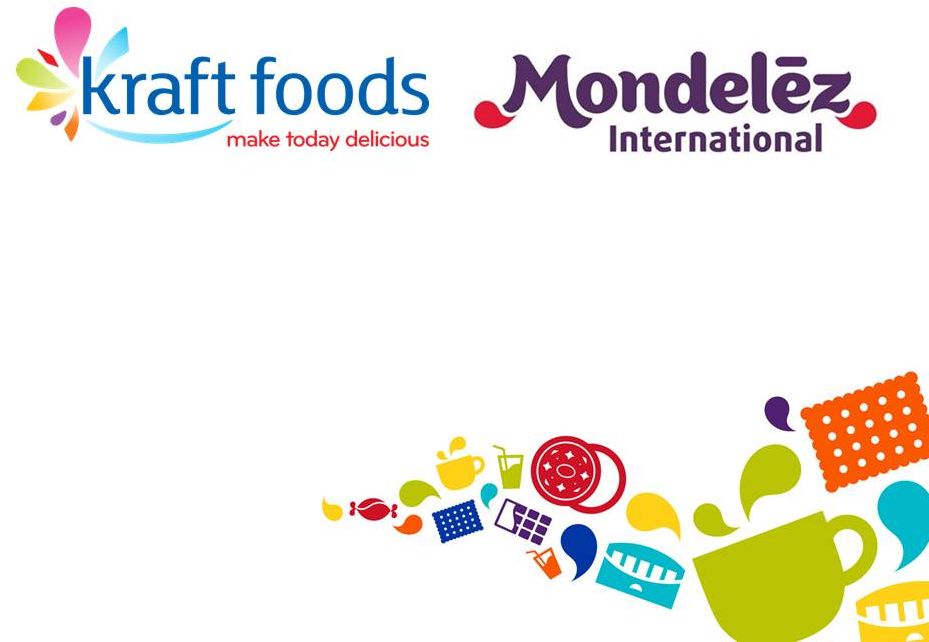 Unleashing a Global Snacking Powerhouse
September 6, 2012
1
Exhibit 99.2 |
 Irene
Rosenfeld Chairman and CEO
2 |
 Forward-looking statements
3
This slide presentation contains a number of forward-looking statements. The words
“plan,” “will,” “deliver,” “drive,”
“continue,” “focus,” “maintain,” and similar expressions are intended to identify our
forward-looking statements. Examples of forward-looking statements include, but
are not limited to, our International as an unique investment vehicle; snacks are growth categories; expectations for
BRIC countries; expectations for Next Wave markets; 5-year revenue growth outlook
for developing markets; our strategy to deliver top-tier performance; North America
growth and margin upside; expectations for Europe; driving efficiency; Global Category
Teams; global innovation platforms; selling; Priority Markets; maintaining leadership;
Power Brands and Priority Markets growth; Gum category, including market share;
Chocolate growth and developing markets as primary driver; our virtuous cycle; gross margin;
overheads; reinvesting in growth; long-term targets; Free Cash Flow; long-term
EPS; 2013 Outlook; and our expectation that efficiency will fuel growth. These
forward-looking statements involve risks and uncertainties, many of which are
beyond our control, and important factors that could cause actual results to differ
materially from those in the forward-looking statements include, but are not limited to, our failure
to successfully create two companies, continued global economic weakness, continued volatility
and increase in input costs, increased competition, pricing actions, our debt and our
ability to pay our debt and tax law changes. For additional information on these
and other factors that could affect our forward- looking statements, see our risk
factors, as they may be amended from time to time, set forth in our filings with the
SEC, including our most recently filed Annual Report on Form 10-K and subsequent reports
on Forms 10-Q and 8-K. We disclaim and do not undertake any obligation to update
or revise any forward-looking statement in this slide presentation, except as
required by applicable law or regulation.
opportunity
for
growth
as
two
independent
companies;
setting
Kraft
Foods
on
a
new
trajectory;
Mondelez
- |
 Agenda
Unleashing a global snacking powerhouse
Leveraging our global categories
–
Biscuits
–
Gum and Candy
–
Chocolate
Delivering top-tier financial performance
4 |
 Successfully set Kraft Foods on a new trajectory
Delivered strong performance
Transformed portfolio and geographic footprint
Successfully integrated LU and Cadbury
Enhanced market positions to become #1 or #2
in all core categories
Created a virtuous cycle in each geography
5 |
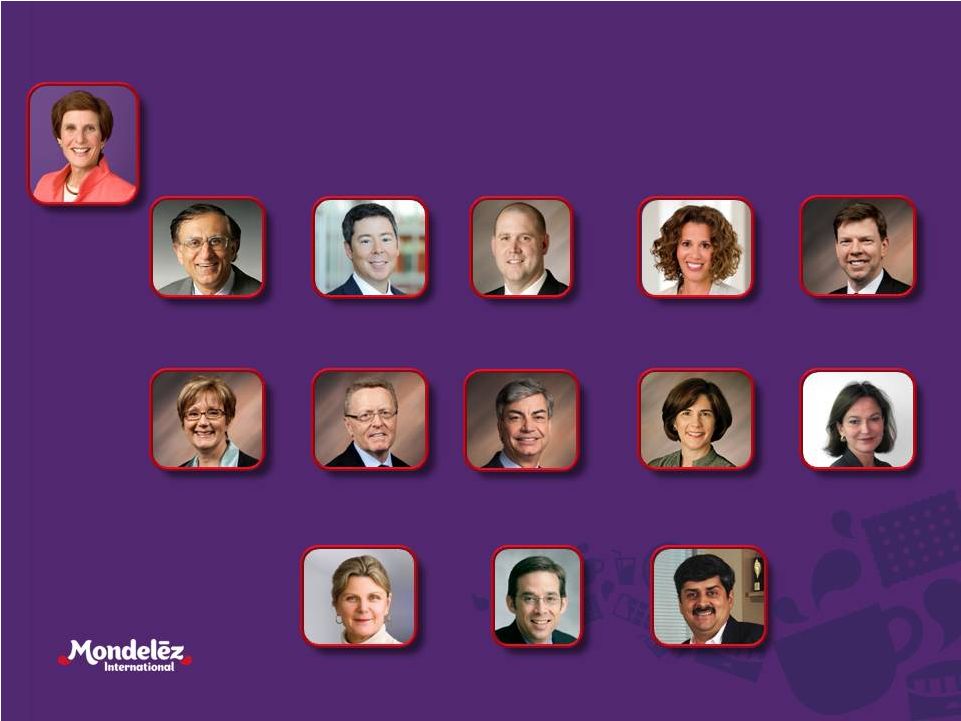 Daniel Myers
EVP, Integrated
Supply Chain
Gerd Pleuhs
EVP, Legal Affairs
and General Counsel
Mary Beth West
EVP and Chief Category
and Marketing Officer
David Brearton
EVP and Chief
Financial Officer
Our world-class leadership will build on these results
6
Irene Rosenfeld
Chairman and Chief Executive Officer
Sanjay Khosla
EVP and President,
Developing Markets
Tim Cofer
EVP and President,
Europe
Mark Clouse
EVP and President,
North America
Karen May
EVP, Human
Resources
Jean Spence
EVP, Research,
Development & Quality
Tracey Belcourt
EVP, Strategy
Lorna Davis
SVP, Global Category
Leader Biscuits
Jim Cali
SVP, Global Category
Leader Gum & Candy
Bharat Puri
SVP, Global Category
Leader Chocolate |
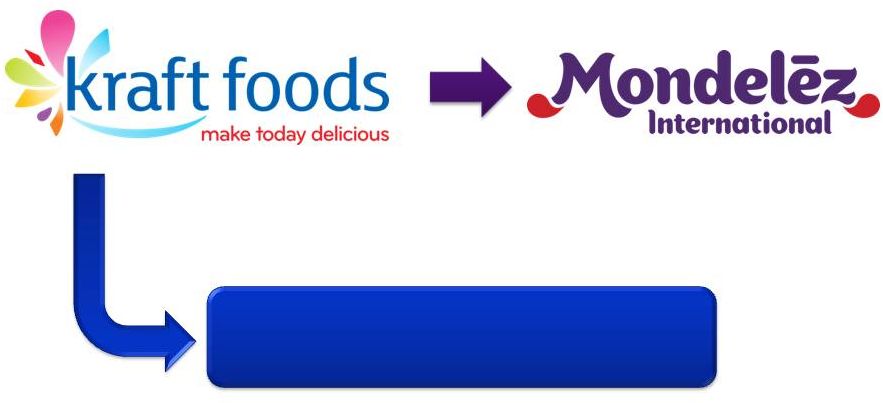 Opportunity to accelerate growth as two independent
companies
7
Kraft Foods Group, Inc. |
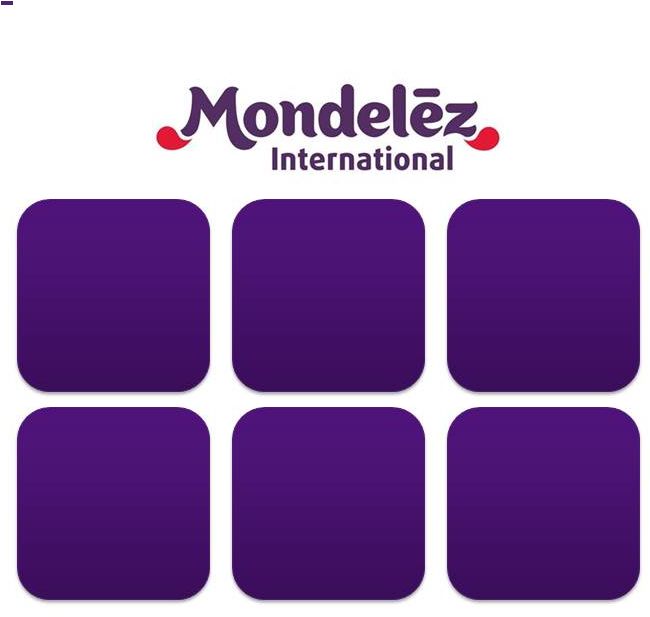 8
Fast-
Growing
Categories
Advantaged
Geographic
Footprint
Favorite
Snacks
Brands
Strong
Route-to-
Market
Proven
Innovation
Platforms
World-Class
Talent &
Capabilities
Mondelez International is a unique investment vehicle |
 Snacks
are growth categories Well-aligned with consumer trends
Expandable consumption
Developing Markets consumption
supported by GDP growth
Higher margins
9 |
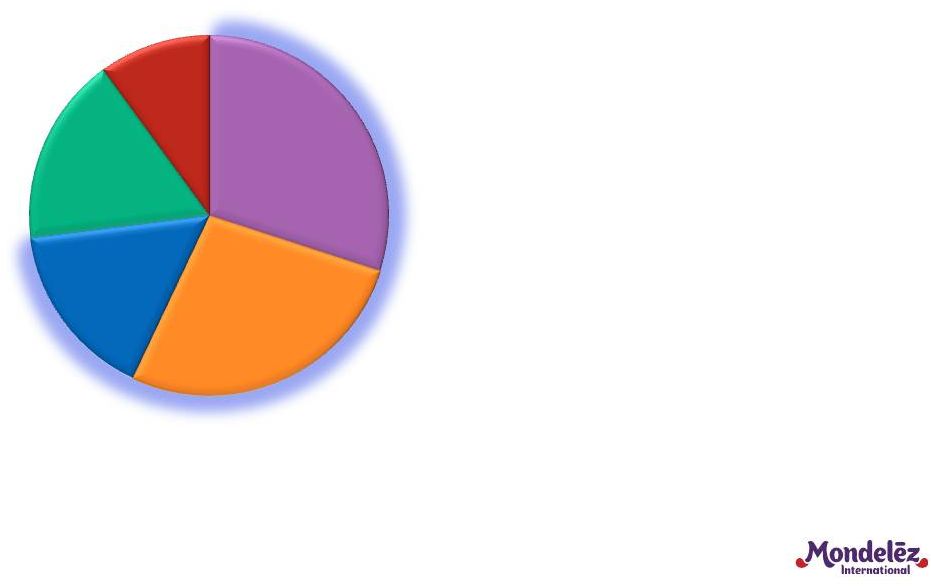 We are
a global snacks powerhouse … 10
$36 Billion in Revenues
(2)
•
Nearly 75% of revenues
in fast-growing snacks
categories
•
Beverages provide multi-
region scale, attractive
growth and strong margins
Biscuits
(1)
30%
Chocolate
27%
Gum &
Candy
16%
Beverages
17%
Cheese &
Grocery
10%
(1)
Biscuits includes salty/other snacks
(2)
Based
on
2011
reported
net
revenues;
includes
accounting
calendar
changes
and
53
Week.
rd |
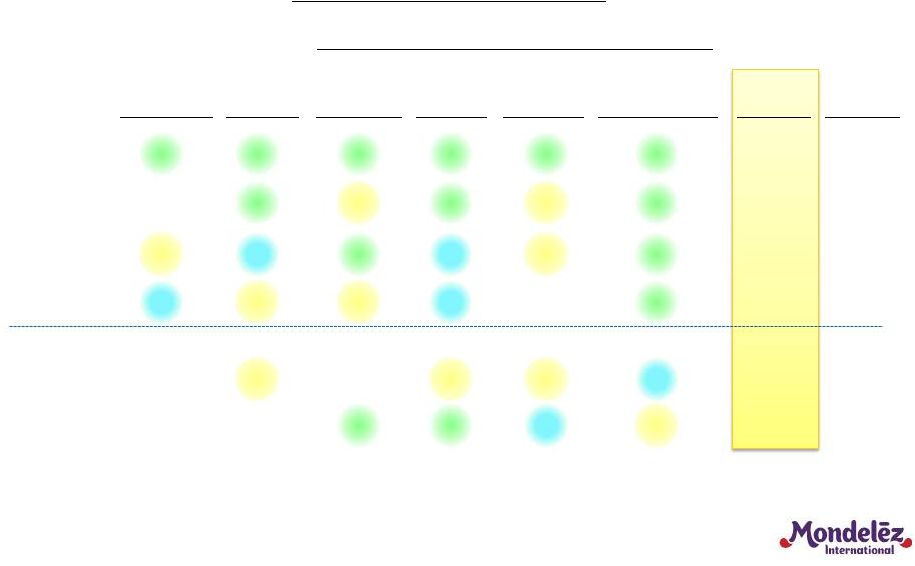 …
and a leader in our categories
11
North
America
Europe
Latin
America
Asia
Pacific
Eastern
Europe
Middle East
& Africa
Global
Developing Markets
Source: Euromonitor 2011, Kraft Foods analysis
Share
Market Share Position
Biscuits
#1
#1
#1
#1
#1
#1
#1
18%
Chocolate
#5
#1
#2
#1
#2
#1
#1
15%
Gum
#2
#3
#1
#3
#2
#1
#2
30%
Candy
#3
#2
#2
#3
--
#1
#1
7%
Coffee
--
#2
--
#2
#2
#3
#2
11%
Powdered
--
--
#1
#1
#3
#2
#1
16%
Beverages |
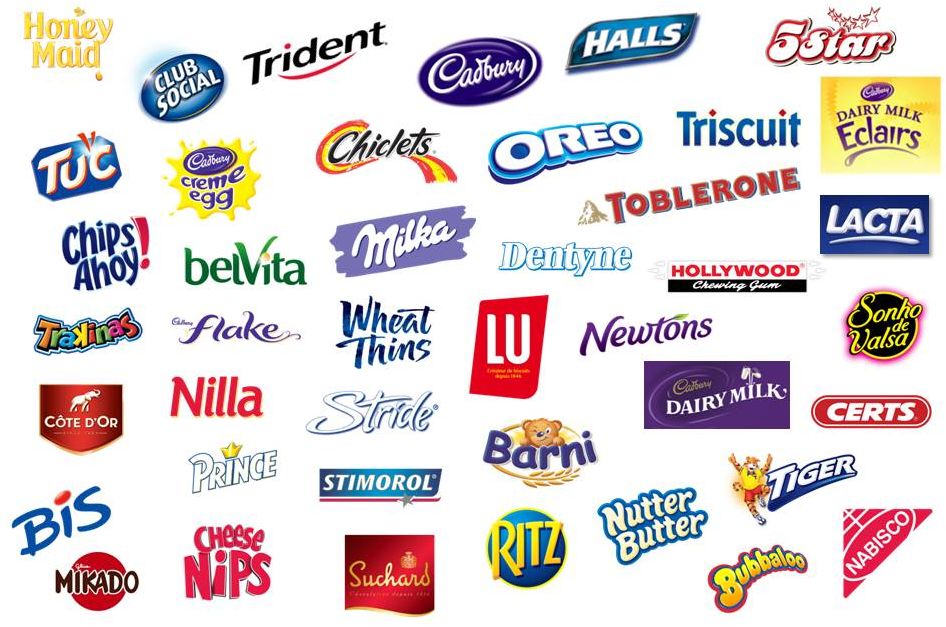 We
offer many of the world’s favorite snacks brands 12
|
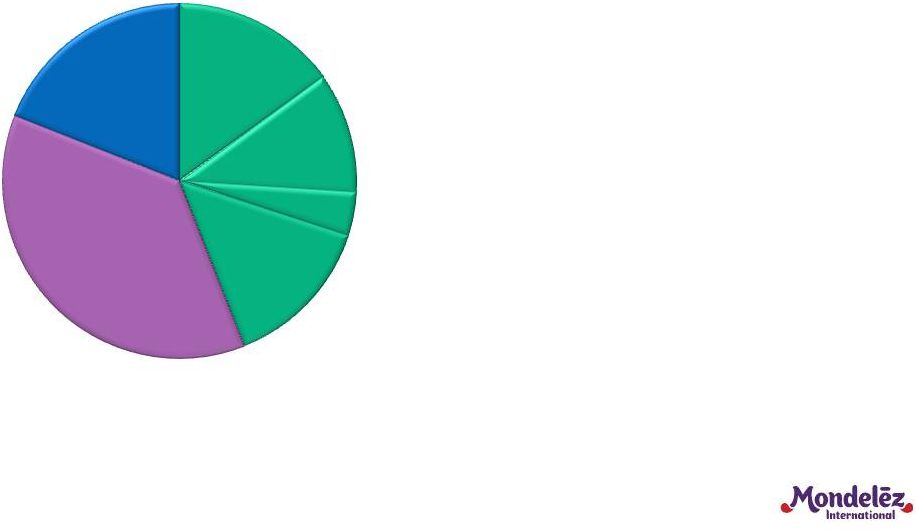 Each
region plays a critical role in our strategy $36 Billion*
Latin
America
MEA
Asia
Pacific
Europe
37%
North
America
19%
Developing
Markets
44%
CEE
•
Large, growing Developing
Markets footprint
•
Strong, advantaged
positions in North America
and Europe
•
Broad-based growth across
categories and geographies
13
*
Based
on
2011
reported
net
revenues;
includes
accounting
calendar
changes
and
53
rd
Week. |
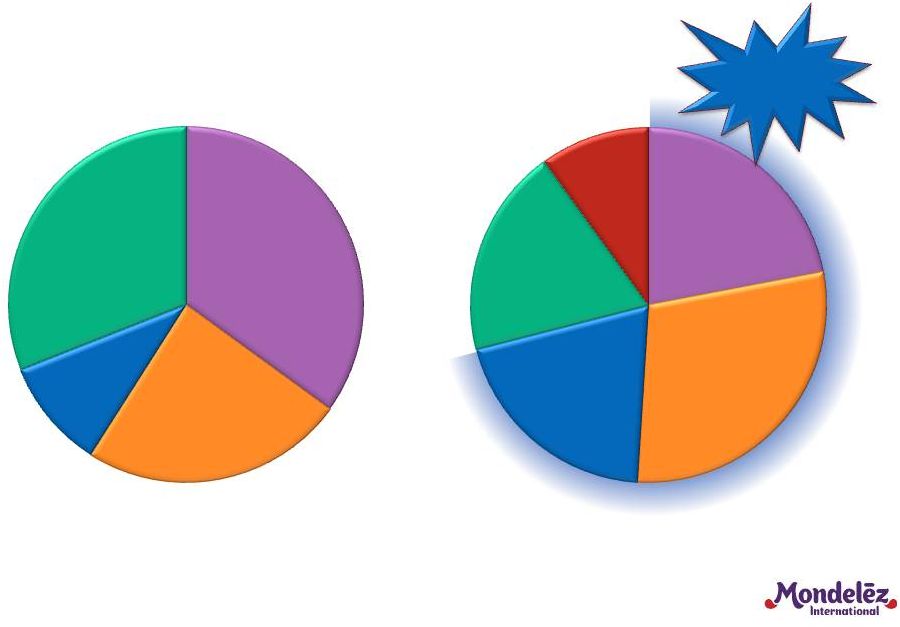 Developing Markets: Strong geographic and
category footprint
14
$16 billion
(2)
Biscuits
(1)
22%
Chocolate
29%
Gum &
Candy
20%
Latin
America
35%
Central &
Eastern
Europe
24%
Middle East
& Africa
10%
Asia Pacific
31%
70%+
Snacks
Beverages
19%
Cheese
&
Grocery
10%
(1)
Biscuits includes salty/other snacks
(2)
Based
on
2011
reported
net
revenues;
includes
accounting
calendar
changes
and
53
Week.
rd |
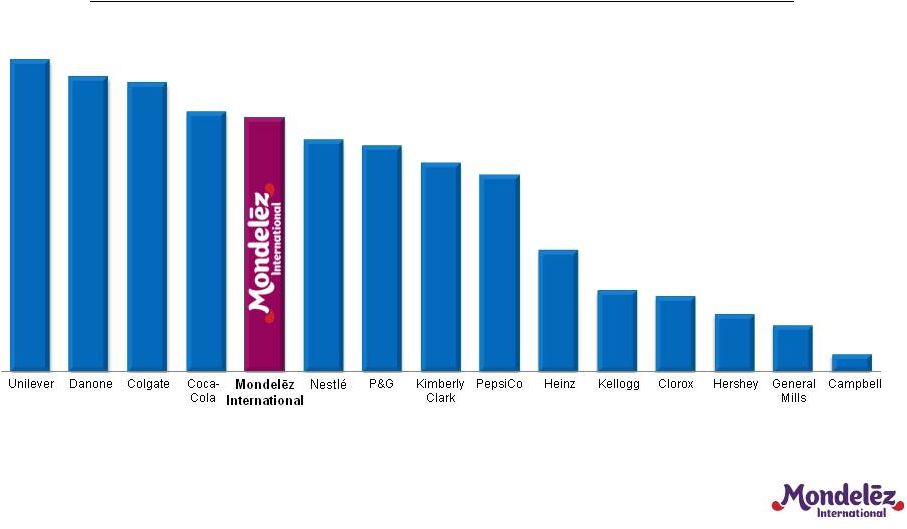 We
rank among the leading CPG players in developing markets
15
Source: Company reports and presentations. See page 93 for source
details. Percentage of Revenues from Developing Markets
54%
51%
50%
45%
44%
40%
39%
36%
34%
21%
14%
13%
10%
8%
3% |
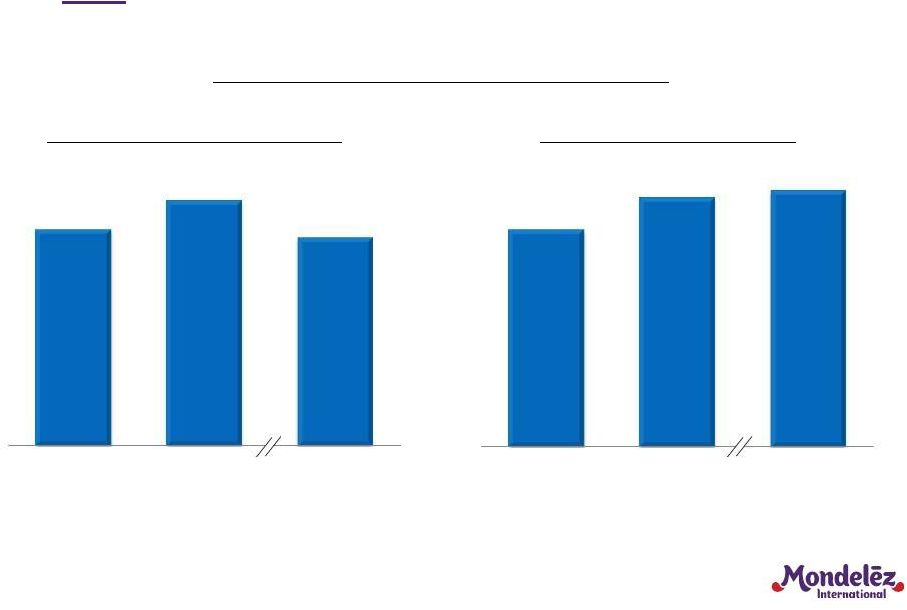 5-10-10 focus strategy has driven both
top-
and
bottom-line growth
16
Organic Net Revenue Growth
(1)
Adjusted Segment
Operating Income Margin
(2)
Kraft Foods Developing Markets
(1)
Organic Net Revenue growth excludes the impact of acquisitions in the first 12
months after the acquisition date. Reported Net Revenue growth for 2010, 2011 and
1H 2012 was 71.1%, 16.2% and 2.2%, respectively. See GAAP to Non-GAAP
Reconciliation at the end of this presentation. (2)
Adjusted Segment Operating Income margin excludes Integration Program costs and
Restructuring Program costs. Reported Segment Operating Income Margin for
2010,
2011
and
1H
2012
was
11.6%,
13.0%
and
13.7%,
respectively.
See
GAAP
to
Non-GAAP
reconciliation
at
the
end
of
this
presentation.
9.9%
13.1%
9.5%
11.2%
14.0%
14.2%
2010
2011
H1 2012
2010
2011
H1 2012 |
 Three
priority clusters within Developing Markets 17
China
India
Russia
Brazil
5-Yr Revenue
Growth Outlook
% DM 2011
Revenue
33%
Mid-to-High Teens
BRIC |
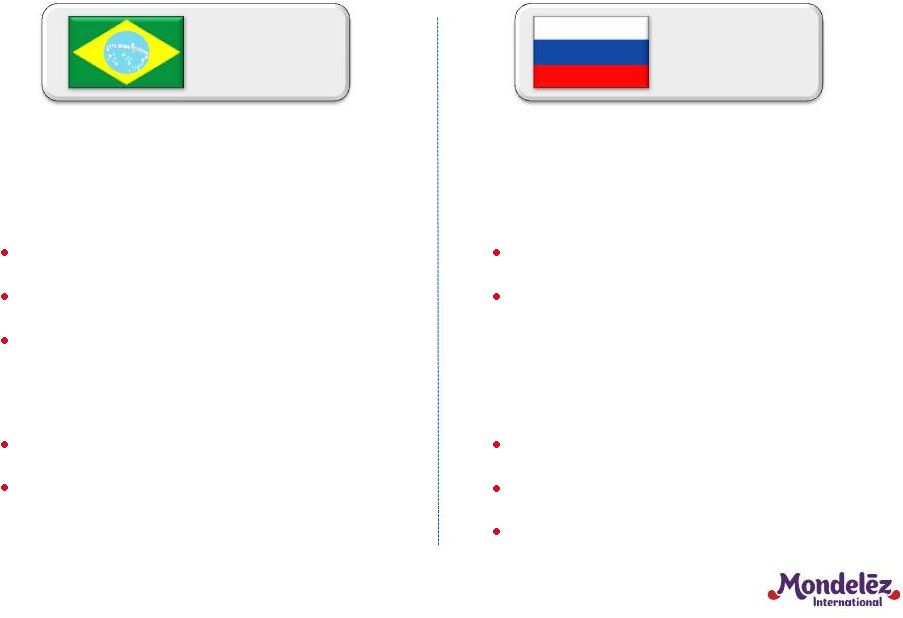 Win in
BRIC 18
Brazil
Revenue:
$2+ billion
Portfolio
80% Snacks
15% Beverages (powdered)
5% Cheese & Grocery
Strategic Priorities
“Strengthen the Fortress”
Drive growth in North/NE Region
Russia
Revenue:
$1+ billion
Portfolio
70% Snacks
30% Beverages (soluble coffee)
Strategic Priorities
Focus on premium brands
Drive global platforms
Expand distribution |
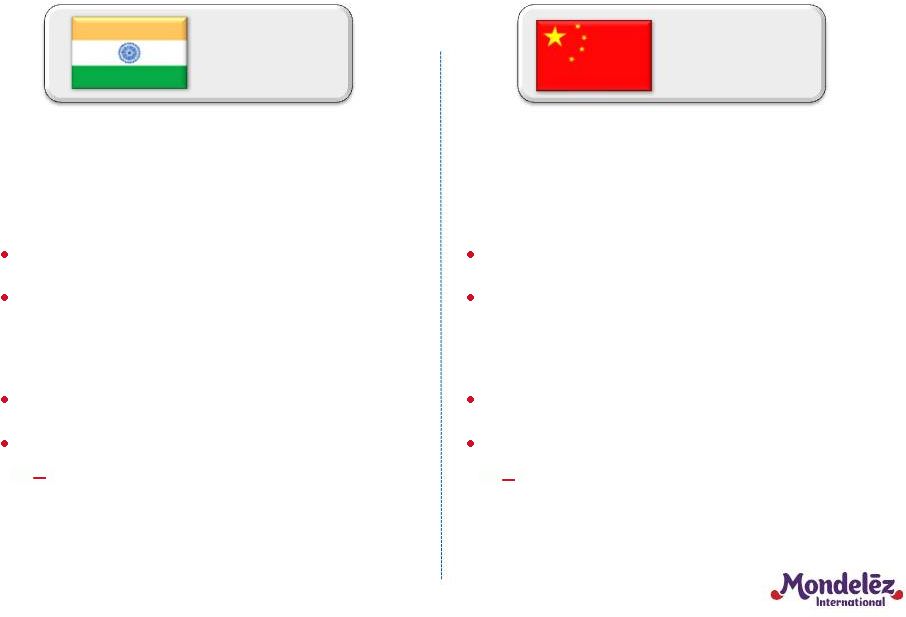 Win in
BRIC 19
India
Revenue:
$0.7 billion
Portfolio
80% Snacks, primarily Chocolate
20% Beverages (malt)
Strategic Priorities
Expand Chocolate distribution
Launch White Space categories
Launched Oreo
and Tang
in 2011;
Toblerone
in 2012
China
Revenue:
$0.8 billion
Portfolio
90% Snacks, primarily Biscuits
10% Beverages (powdered, coffee)
Strategic Priorities
Expand Biscuits distribution
Launch White Space categories
Launched Stride in August 2012 |
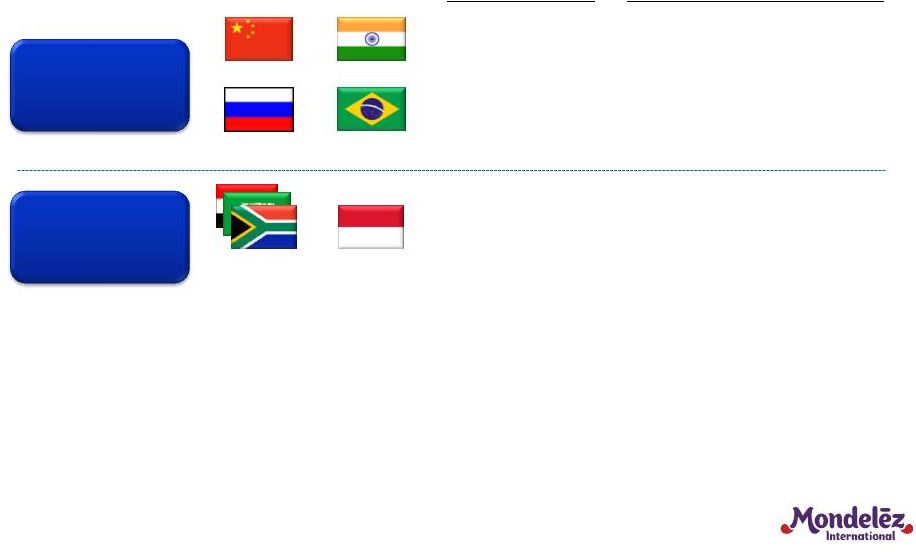 Middle East
& Africa
Indonesia
Three priority clusters within Developing Markets
20
China
India
Russia
Brazil
5-Yr Revenue
Growth Outlook
% DM 2011
Revenue
33%
12%
Mid-to-High Teens
Mid-to-High Teens
BRIC
Next Wave
Markets |
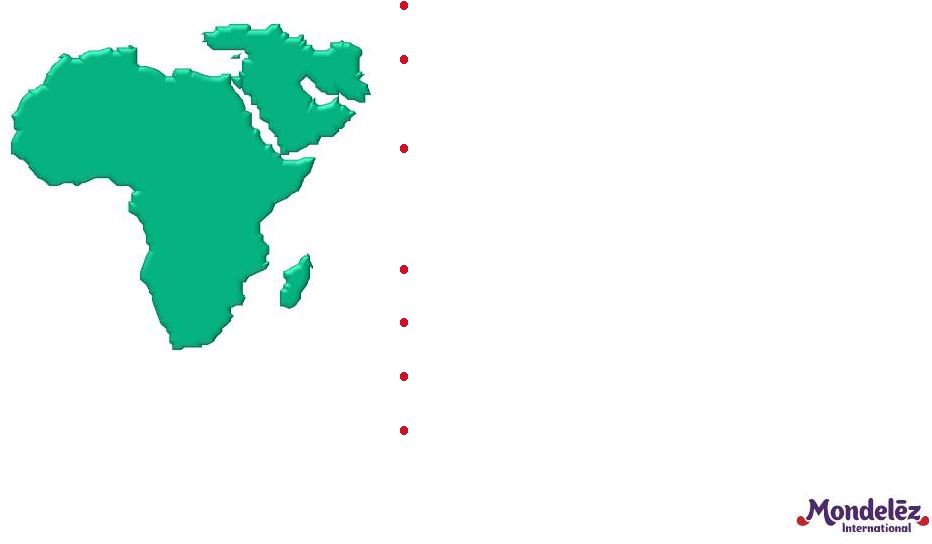 Next
Wave Markets: Middle East & Africa 21
Region full of opportunities
2 billion consumers by 2020
*
Additional $1 trillion of wealth from
aspirant and middle class by 2020
*
Snacks growing double-digits
Well-positioned to capture growth
Focused snacks portfolio
Broad geographic footprint
Established routes-to-market
Strong profitability
2011 Revenue: $1.6B
* Source: Canback Global Income Distribution Database and Euromonitor.
|
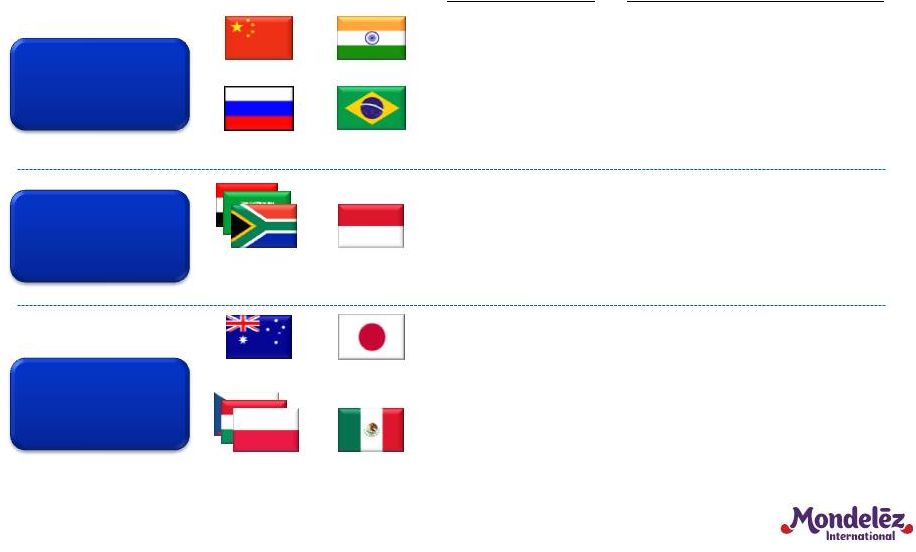 Middle East
& Africa
Indonesia
Australia
Japan
Mexico
Central
Europe
Three priority clusters within Developing Markets
22
China
India
Russia
Brazil
5-Yr Revenue
Growth Outlook
% DM 2011
Revenue
33%
12%
27%
Mid-to-High Teens
Mid-to-High Teens
Low-to-Mid
Single Digits
BRIC
Next Wave
Markets
Scale
Markets |
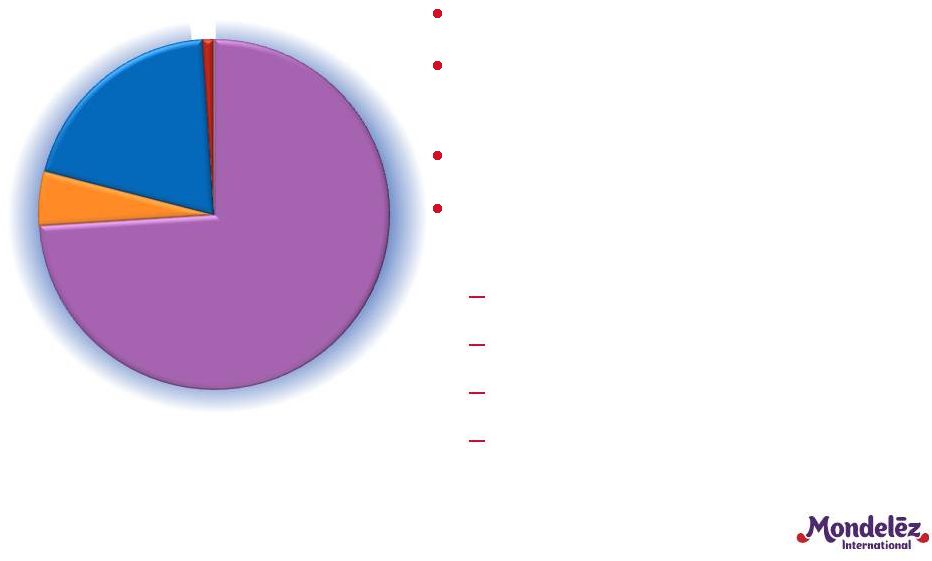 North
America: Solid growth with margin upside 23
$7 billion
(2)
Snacks “pure play”
Leading share of U.S. Biscuit
category, 2x closest competitor
Strong #2 player in Gum
Opportunity to improve growth
and profitability through
Focusing on Power Brands
Driving global innovation platforms
Harnessing power of DSD
Optimizing end-to-end supply chain
Biscuits
(1)
74%
Chocolate
5%
Gum &
Candy
20%
Other
1%
(1)
Biscuits includes salty/other snacks
(2)
Based
on
2011
reported
net
revenues;
includes
accounting
calendar
changes
and
53
rd
Week. |
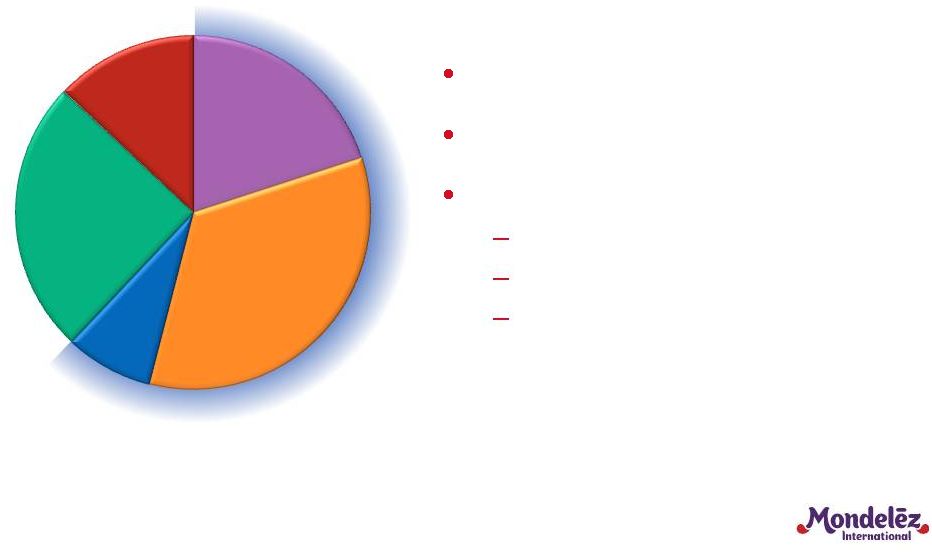 Europe: Continue to drive top-tier performance in a
challenging environment
24
Biscuits
(1)
20%
Chocolate
35%
Gum &
Candy
8%
Beverages
24%
Cheese &
Grocery
13%
60%+ of revenues in Snacks
#1 or #2 share in each category
Continued margin opportunities
Portfolio mix
Productivity
Overheads
$13 billion
(2)
(1)
Biscuits includes salty/other snacks
(2)
Based
on
2011
reported
net
revenues;
includes
accounting
calendar
changes
and
53
rd
Week. |
 Our
strategies to deliver top-tier performance 25
Build global Power Brands
Leverage global innovation
platforms
Revolutionize selling
Drive efficiency to fuel growth
Consistently
Deliver
Top-Tier
Revenue and
EPS Growth |
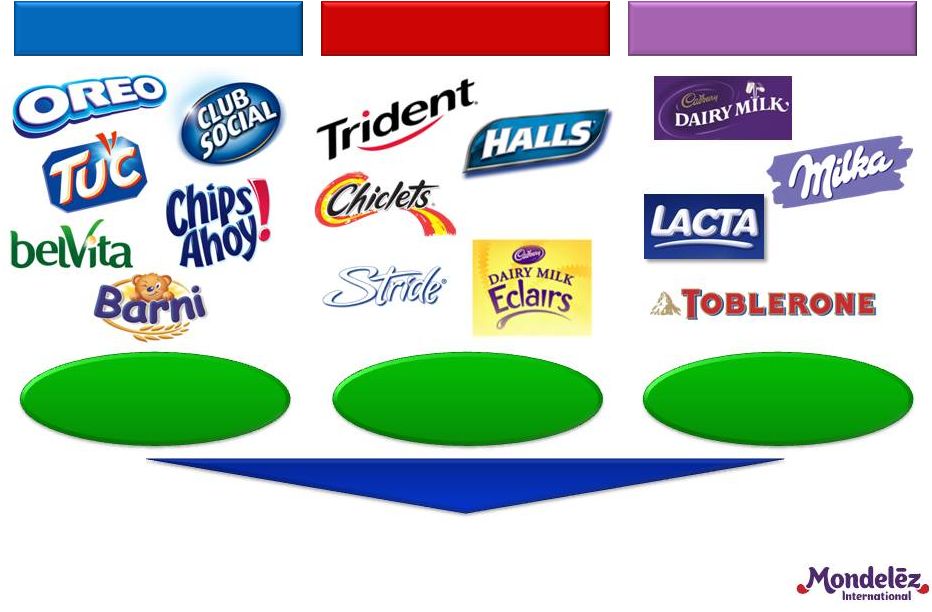 Build
Global Power Brands 26
Biscuits
40% of Biscuit
Revenue
Gum & Candy
60% of Gum &
Candy Revenue
Chocolate
50% of Chocolate
Revenue
Drive 70% of Growth |
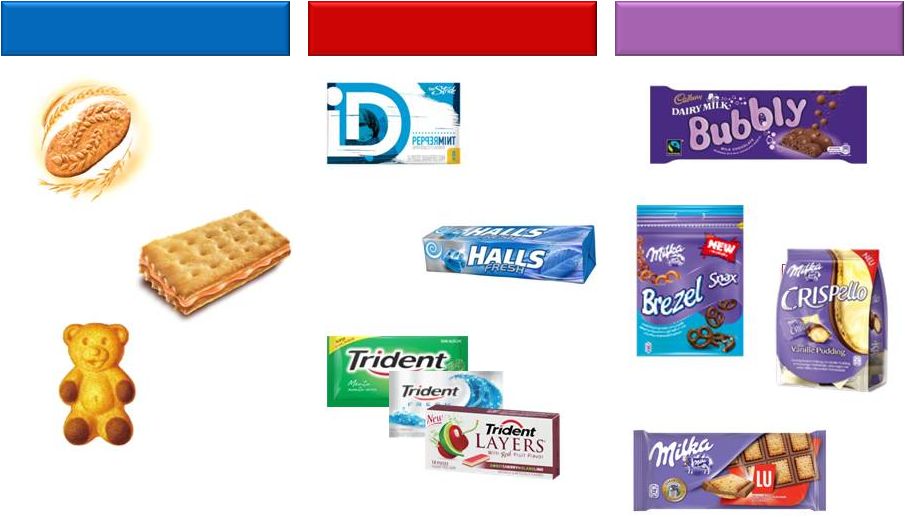 Leverage Global Innovation Platforms
27
Sustaining
Energy
Children
Wholesome
Hunger
Satisfaction
Teen Market
Penetration
Advantaged
Candy Brands
Drive Frequency
Bubbly
Hollow Wafer
Choco-Bakery
Bitesize
Biscuits
Gum & Candy
Chocolate |
 Revolutionize Selling
Near-term focus:
–
Complete integration of Cadbury
–
Capitalize on route-to-market capabilities
Long-term focus:
–
Develop best-in-class Instant Consumption
Channel / Hot Zone sales and
distribution capabilities
28 |
 Drive
Efficiency to Fuel Growth Expand gross margin
–
Price to offset input cost inflation
–
Optimize product mix
–
Deliver industry-leading productivity
Reduce overheads as a percent of revenue
–
Drive top-line growth
–
Capture Restructuring Program savings
–
Align overhead support to growth priorities
29 |
 Global
Category Teams are the cornerstone of these strategies
30
Drive Bigger,
Faster, More
Profitable
Initiatives
Integrated, cross-functional
teams driving a common
category agenda
–
Build brand equity
–
Develop innovation platforms
–
Prioritize resources |
 …
with highly experienced leaders
31
Lorna Davis
SVP and Global
Category Leader
Biscuits
Jim Cali
SVP and Global
Category Leader
Gum & Candy
Bharat Puri
SVP and Global
Category Leader
Chocolate |
 Lorna Davis
SVP and Global Biscuit
Category Leader
32 |
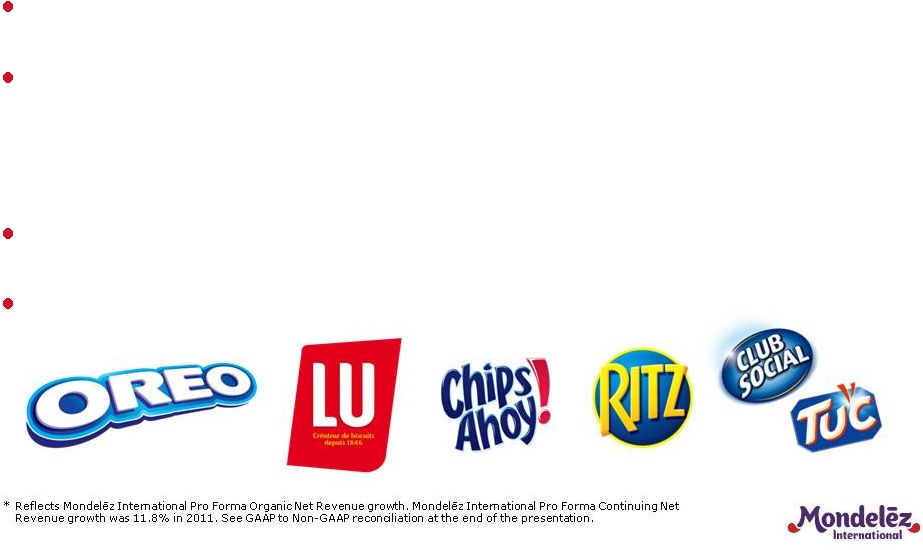 Our
global Biscuits business 2011 Revenue:
$11 billion
2011 Growth:
+9%*
–
Developing Markets up double-digits
–
Developed Markets up mid-single digits
Global Share Position: #1
$500+ Million Brands:
33 |
 Source: Euromonitor 2011 estimates
Biscuits Retail Value ($B)
CAGR
(Cst Fx '09-'11)
$75B Biscuit category with developing markets as the
primary driver
34
$75
$45
$30
8%
11%
2%
Developed
Developing
Global |
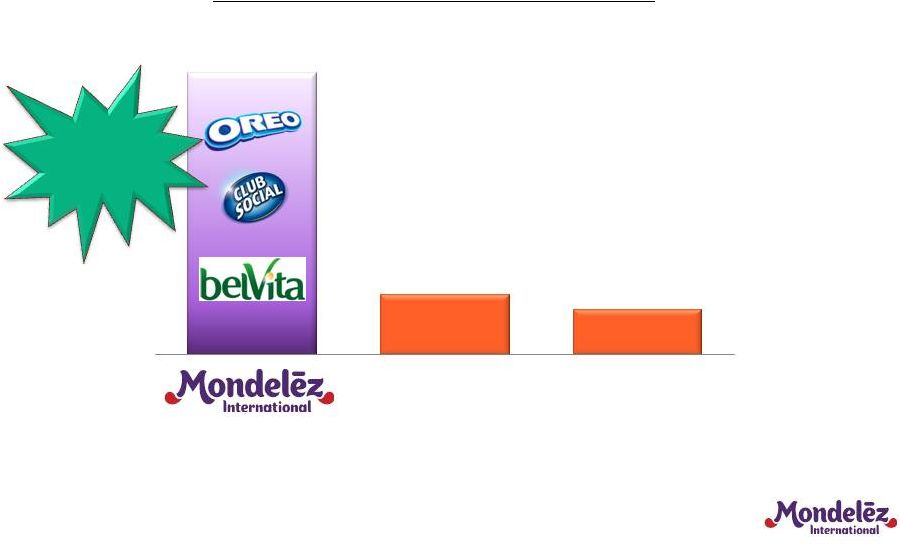 We are
the clear global leader 35
Source: 2011 Euromonitor for global shares
Global Biscuits Market Share
Kellogg
Campbell
>4x
Closest
competitor
18%
4%
3% |
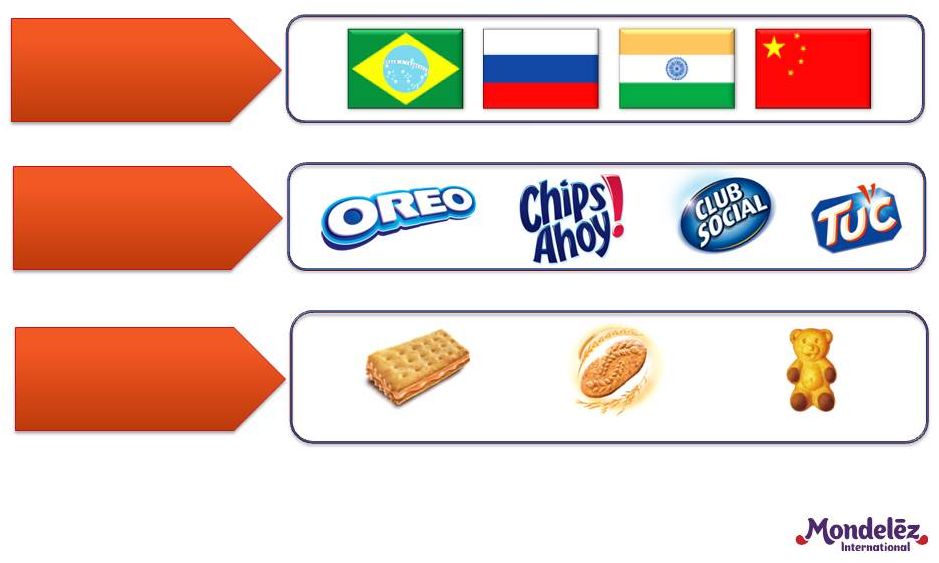 Well-positioned to maintain leadership
36
Focus resources in
Developing Markets
Focus on
Power Brands
Drive Global
Innovation
Platforms
Hunger Satisfaction
Sustaining Energy
Children Wholesome |
 Focusing resources on Priority Markets
37
12%
•
Large, high-growth markets that will
drive revenue growth
•
Strong share in 3 of 4 markets
% Total
Biscuits
Revenue
58%
•
Mature markets with margin upside
to fund growth in Developing Markets
•
Leading market share positions
2%
•
Mature markets with an opportunity
to develop significant biscuit presence
•
Leverage leadership positions in
other categories
2%
•
Larger Next Wave markets with strong
growth potential
•
Solid market share positions |
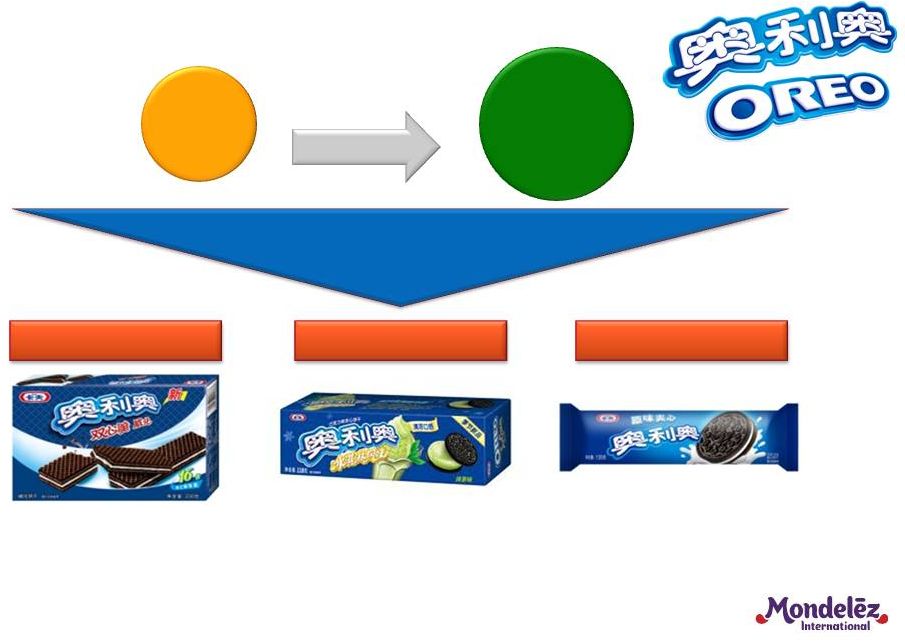 Wafer
“Green
Tea”
for
Traditional
Trade
Priority Markets case study:
Oreo in China
38
+68% CAGR
“Oreo”
GLOCAL model:
Local Form, Flavors,
Formats
$130MM
Revenue
2009
$375MM
Revenue
2011
Form
Flavor
Packaging
Oreo
Oreo
Oreo
|
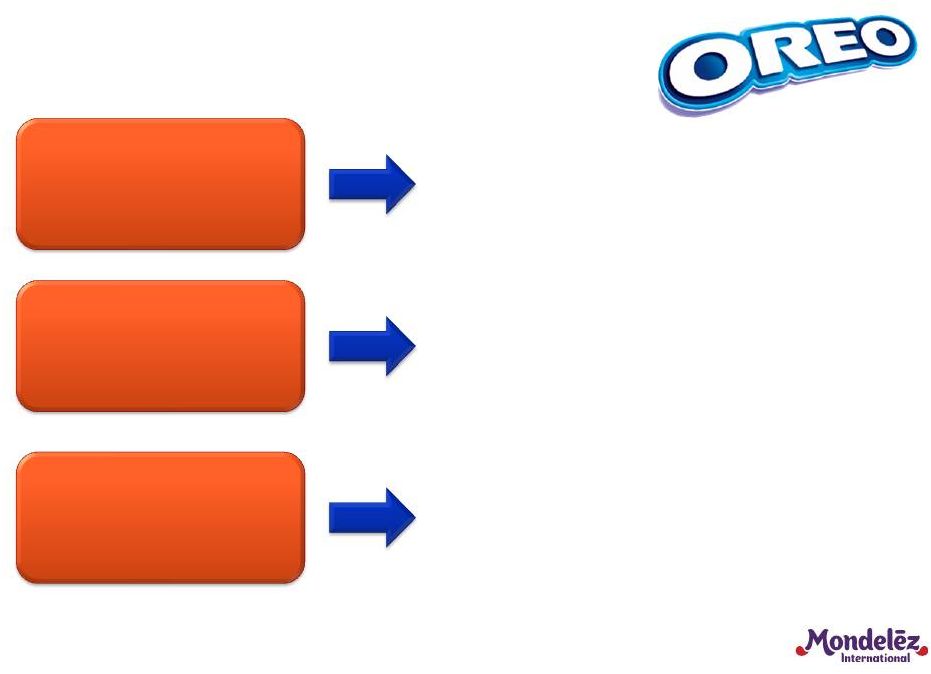 Power
Brand case study: Oreo 39
Capitalize on
Strength in
Developed Markets
Expand in
Developing Markets
Enter White Space
Opportunities
Leverage successful US experience,
up 7%+ in 2011
Use the “China template”
of the
Oreo
playbook
Recent launches in Germany,
France, UK, Czech Republic & India
–
nearly $100MM revenue in 2011 |
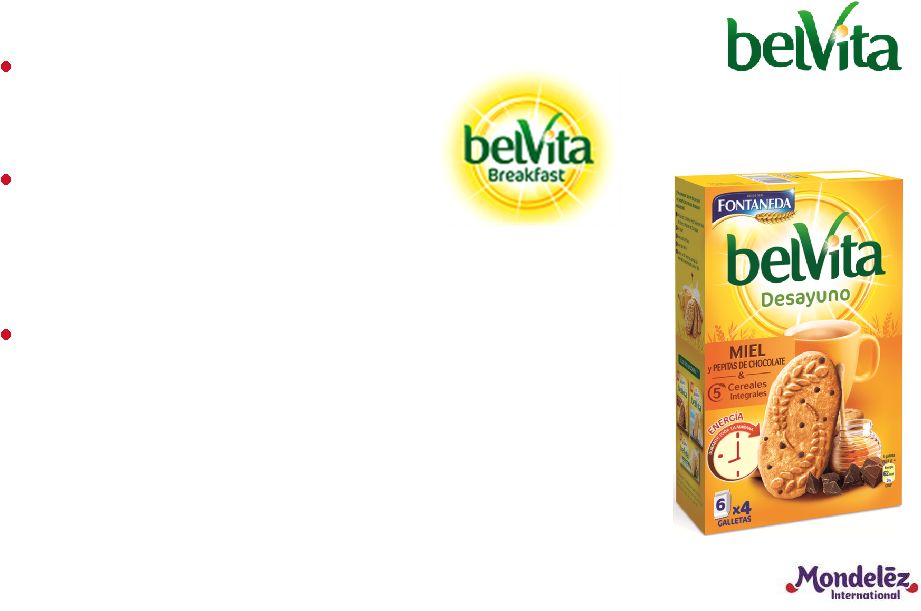 Global
innovation case study: Sustaining Energy Focused on Breakfast
–
#2 Snacking Moment
Proprietary Sustaining
Energy Bundle
–
Anchors health and wellness credentials
Driving Category Growth
–
50%+ incremental to category
40 |
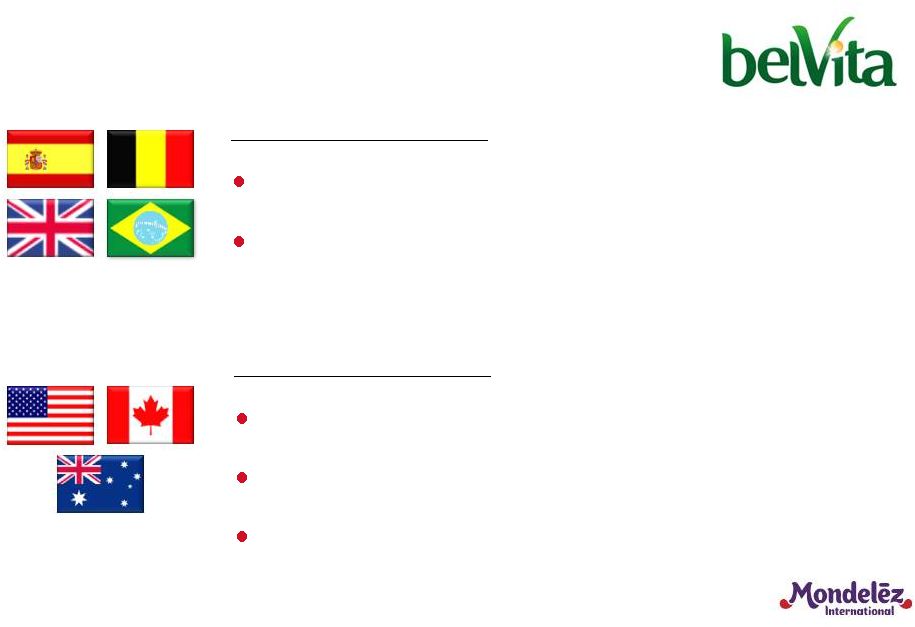 Fast
track global rollout for belVita 41
2011 Launches
2012 Launches
United States
Canada
Australia
Generated nearly $50MM of revenue
Spain, Belgium, UK and Brazil |
 Drive
Power Brands and innovation platforms 42
Focus on Power Brands
and Priority Markets
Rapidly expand innovation
platforms globally
2011 Revenues
$11 Billion
Continue to grow
Mid-to-High
Single Digits |
 Jim
Cali SVP and Global Gum & Candy Category
Leader
43 |
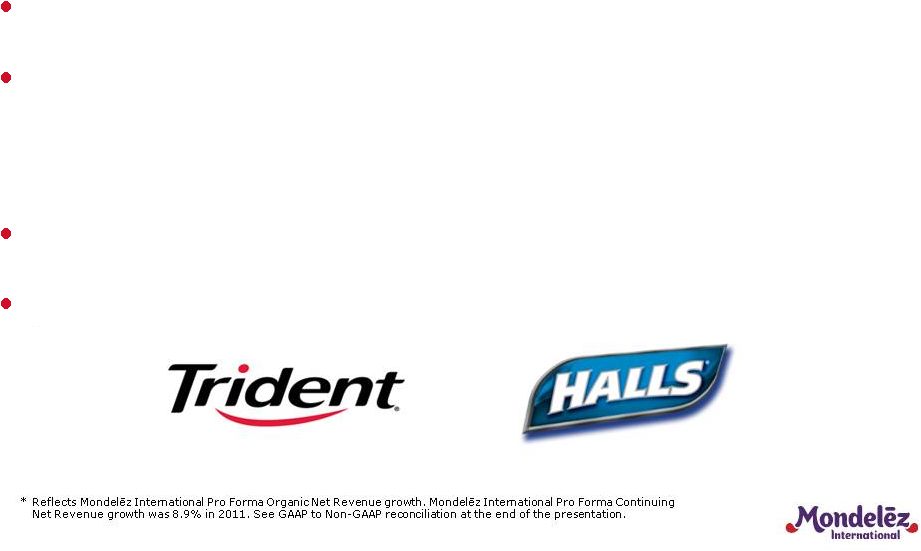 Our
global Gum & Candy business 2011 Revenue:
$6 billion
2011 Growth:
+1%*
–
Developing Markets up mid-single digits
–
Developed Markets down mid-single digits
Global Share Position: #2 in Gum, #1 in Candy
$500+ Million Brands:
44 |
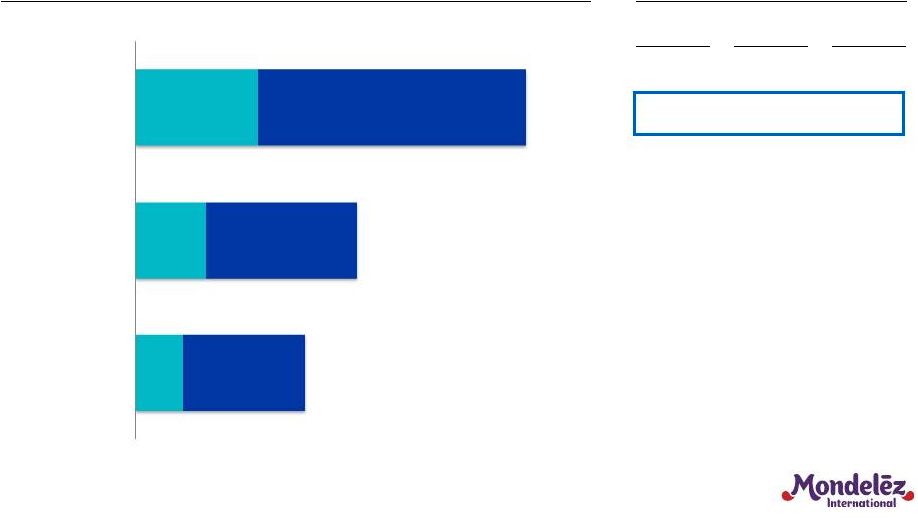 CAGR
(Cst Fx '08-'11)
Gum and Candy are high margin categories
with attractive growth rates
45
Gum & Candy Retail Value ($B)
$83
Gum
Candy
Total
Candy
Gum
$48
$35
3%
4%
4%
6%
7%
7%
2%
0%
1%
Source: Euromonitor 2011 estimates (Gum Adjusted Nielsen Estimate 2011)
Developed
Developing
Global
Gum
10
15
26
26
32
57 |
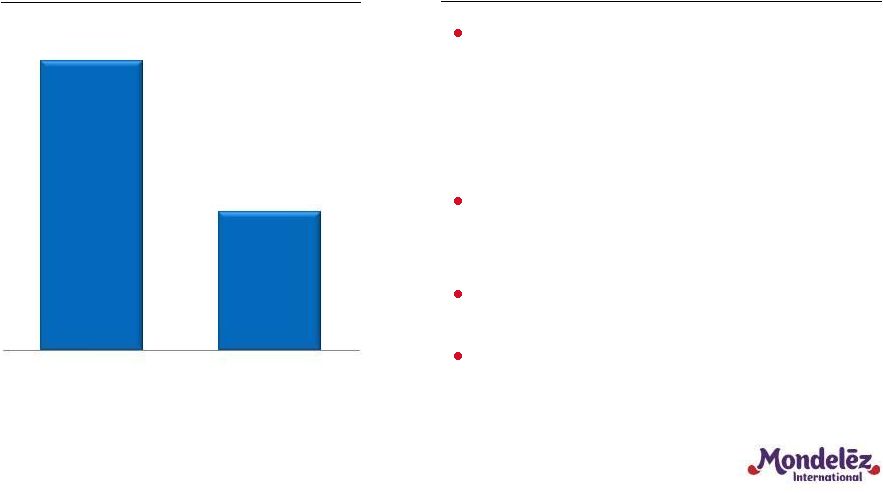 After
a decade of strong growth, the Gum category decelerated over the past 3 years
… 46
Gum Category Growth
(%CAGR)
Key Drivers to Gum
Category Slowdown
Source: Euromonitor (1998-2010), adjusted Nielsen estimates (2011)
Weak macroeconomy
–
GDP softness
–
Unemployment
–
Declining distribution (TDP’s)
Brand and A&C support reduced
and fragmented
Over “premiumization”
Penetration losses among teens
and lower frequency among
adults
7%
3%
'98-'08
'08-'11 |
 …
but the Gum category has strong underlying
fundamentals
Expandable Consumption
–
Snack occasions
–
Impulse-driven
–
Responsive to innovation and marketing
Strong margins fund A&C and innovation investments
Led by global players, with product quality and
innovation insulated by proprietary technologies
47 |
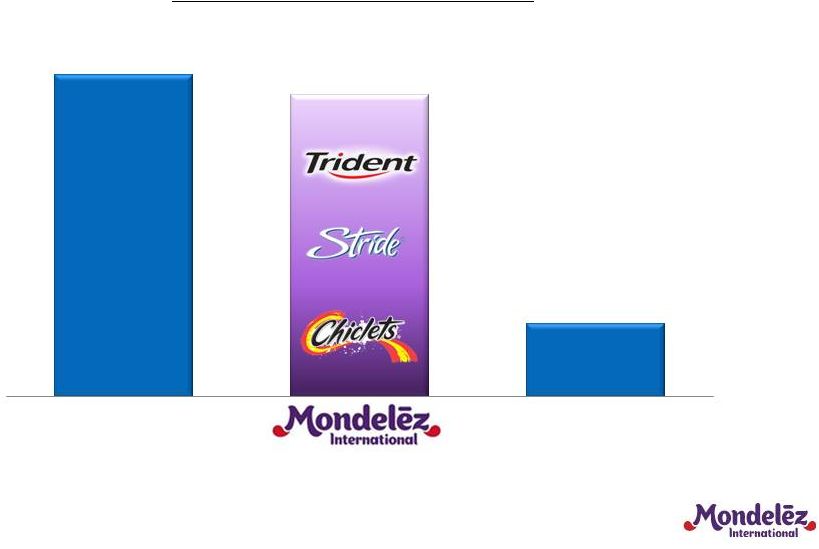 We are
a leader in Gum, with a strong #2 position … 48
Global Gum Market Share
Mars-Wrigley
Perfetti-Van Melle
Source: Gum Adjusted Nielsen Estimate
32%
30%
7% |
 …
and a proven ability to grow share
49
Global Gum Market Share
Value Share based on Euromonitor (’04-’10), Adjusted Nielsen
Estimates (’11) Mars-
Wrigley |
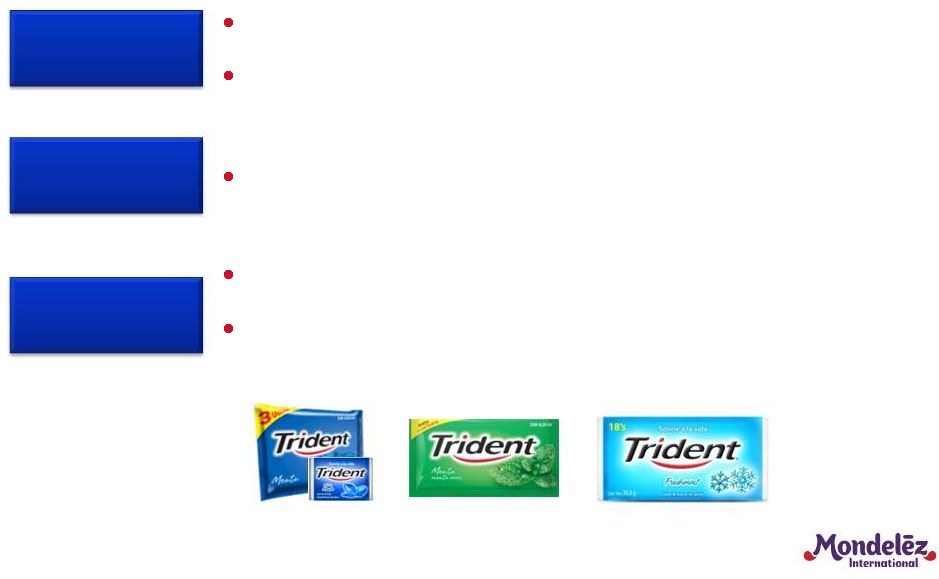 We
have taken near-term actions to grow share and expand the category
50
Price/Size
Architecture
A&C
Support
Brand
Architecture
Drive penetration with entry offers
Expand consumption trading up to larger /
premium offers
Restore A&C support to mid-teens
Simplify brand architecture
Roll-out integrated marketing campaign
Entry
Mid Size
Value |
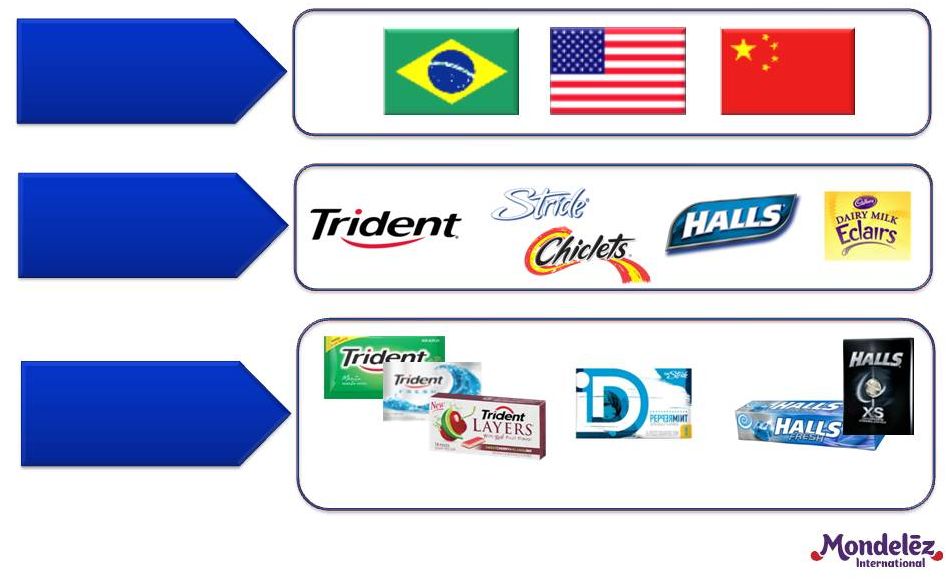 Well-positioned to restore growth and increase
market share in the long-term
51
Focus resources on
Priority Markets
Focus on
Power Brands
Drive Global
Innovation
Platforms
Drive Frequency –
Pleasure/Freshness
Teen Market
Penetration
Advantaged Candy
Brands |
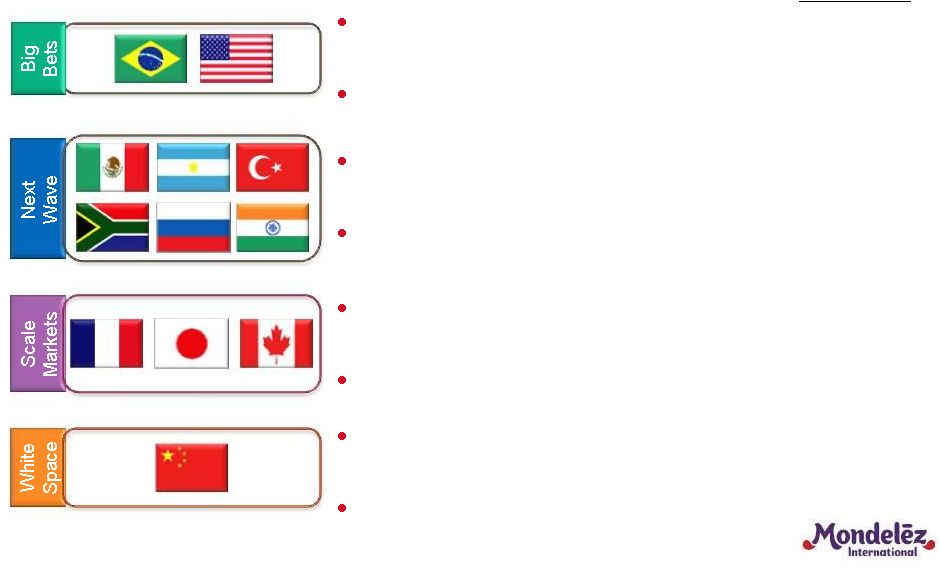 Focusing resources on Priority Markets
52
28%
Large, critical markets with strong
growth potential
Strong market share
% Total Gum
& Candy
Revenue
20%
Larger Next Wave markets with
strong growth potential
Ability to build on solid market share
19%
Mature markets with slow category
growth
Strong market position
1%
White Space market opportunity
for Gum
Launched in China in August 2012 |
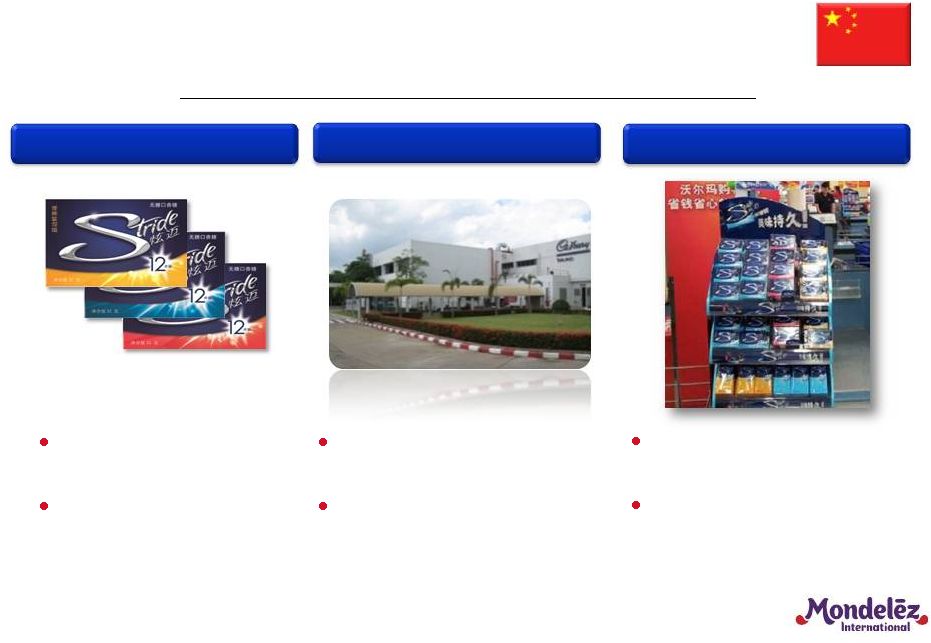 Power
Brand case study: China 53
Launched Stride
in China in August 2012
Launch Bundle
Supply Chain
Sales
Preferred brand
proposition
Product and
packaging
superiority
Built strong Hot-Zone/
Impulse capabilities
Strong trade reception
Best in class
manufacturing start up
Growth/capacity plans
in place |
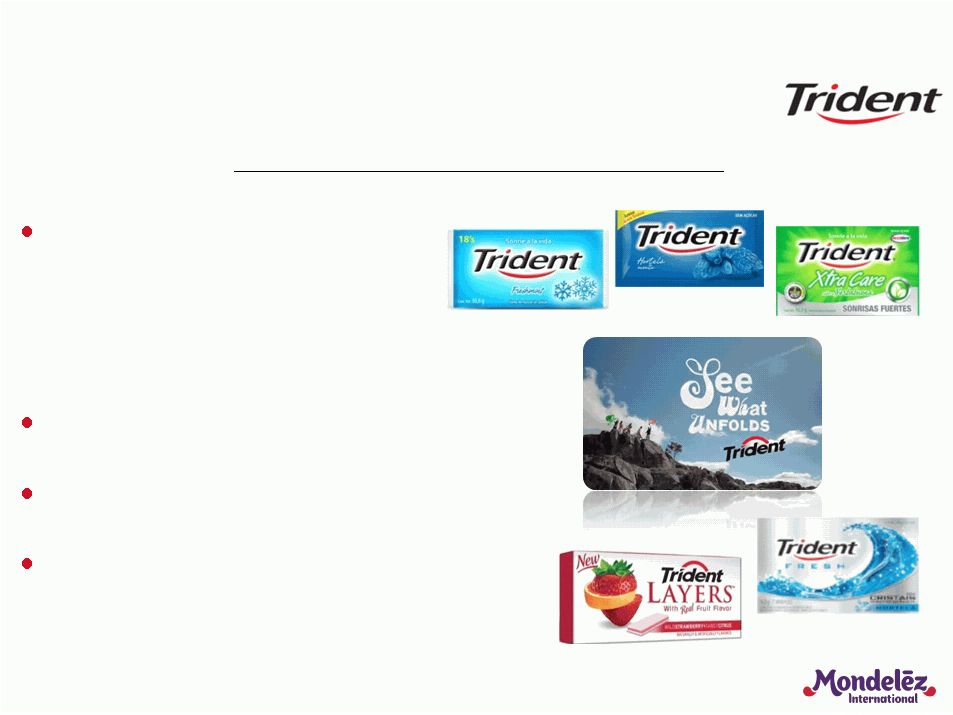 Power
Brand case study: Trident Strong Rights to Win
–
#1 global gum brand
–
High historic growth driven
by innovation
Simplify brand architecture
New master brand campaign
Innovation to drive growth,
new occasions
54
U.S.
Brazil
Unleash Power of “One”
Trident |
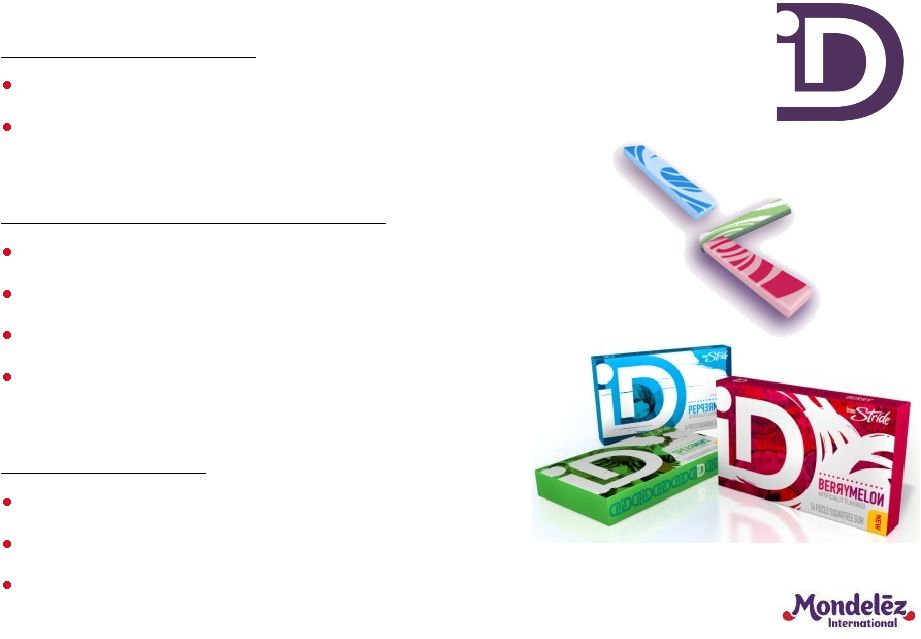 Global
innovation case study: ID Teen-Specific Gum
First-to-Market Technologies
Global Roll-Out
55
Heaviest user cohort
Gum/Candy flavor blends
Printed flavor swirls
Magnetic closure
Artwork from emerging young artists
Launched in U.S. in August 2012
Europe roll-out in Q4 2012
Further geographic expansion 2013-14
Co–created via teen immersion |
 Rebuild
category growth Focus on Power Brands
and Priority Markets
Rebuild category growth
–
Simplify brand and
price/size architectures
–
Step-up innovation
–
Restore A&C support
56
2011 Revenues
$6 Billion
Return to
Mid-Single Digit
Growth |
 Bharat Puri
SVP and Global Chocolate Category Leader
57 |
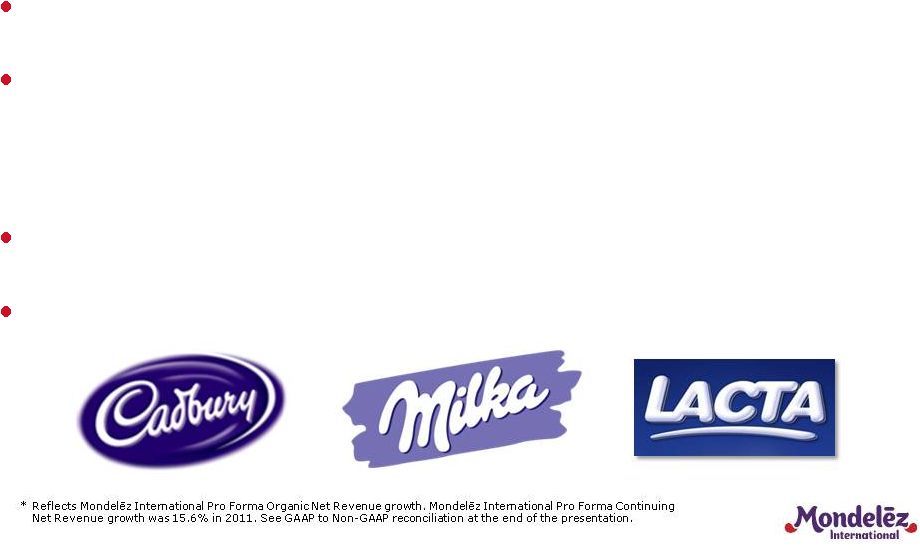 Our
global Chocolate business 2011 Revenue:
$10 billion
2011 Growth:
+6%*
–
Developing Markets up double digits
–
Developed Markets up low-single digits
Global Share Position: #1
$500+ Million Brands:
58 |
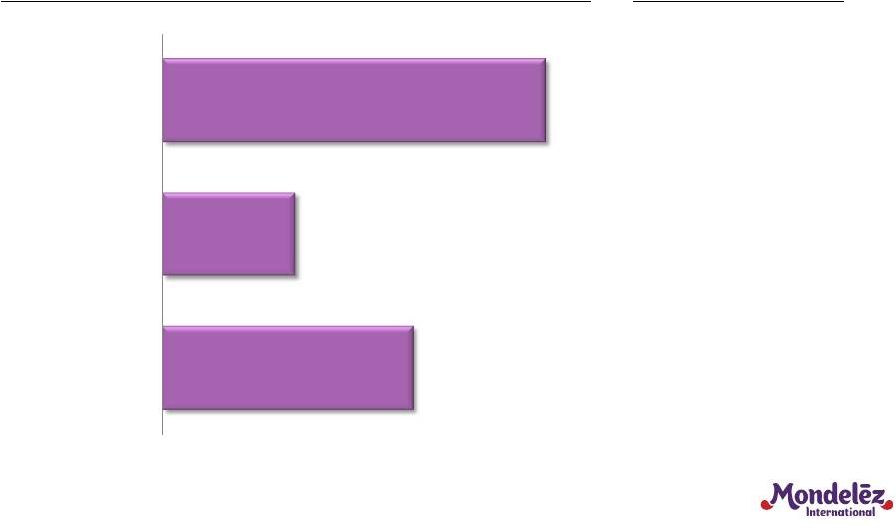 Chocolate Retail Value ($B)
CAGR
(Cst Fx '08-'11)
$101B Chocolate category growth driven by
developing markets
59
5%
$101
$35
$66
10%
2%
Source: Euromonitor 2011 estimates
Developed
Developing
Global |
 We are
a leading chocolate company 60
Source: 2011 Euromonitor for global shares
Mars
Nestle
Ferrero
Hershey
Lindt
Global Chocolate Market Share
15%
15%
12%
7%
7%
4% |
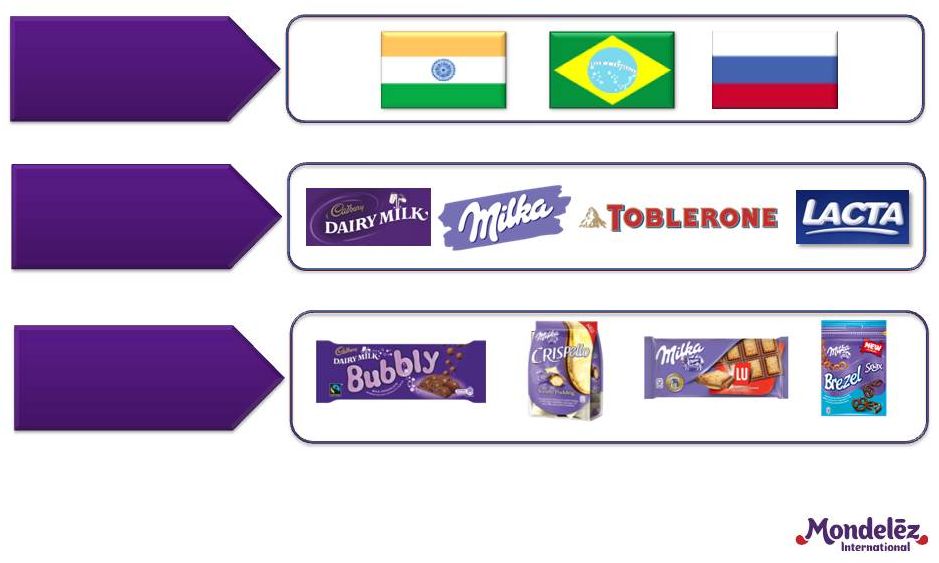 Well-positioned to continue top-tier growth
in Chocolate
61
Focus resources on
Priority Markets
Focus on
Power Brands
Drive Global
Innovation
Platforms
Bubbly
Hollow Wafer
Choco-Bakery
Bitesize |
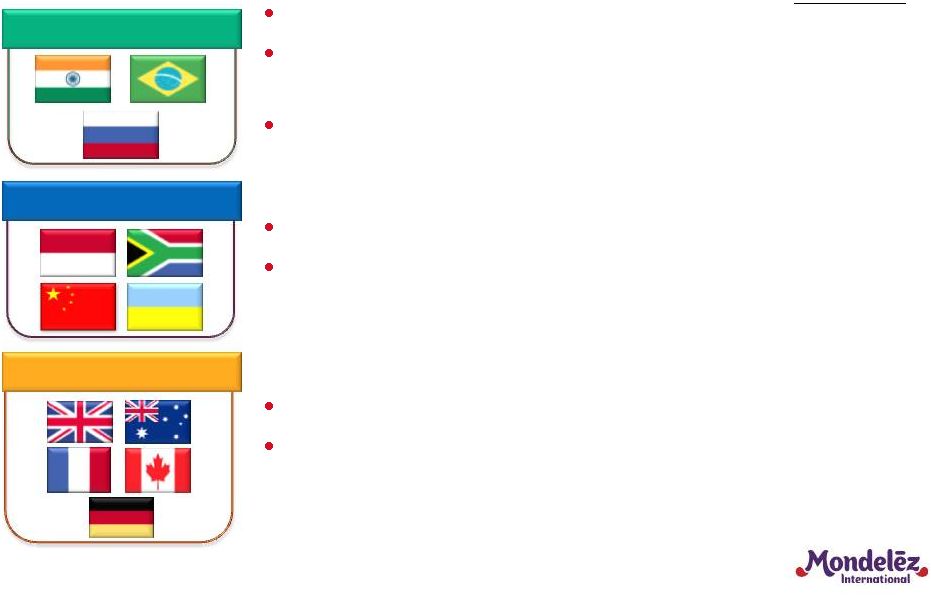 Focusing resources on Priority Markets
62
20%
Large, fastest growing markets
Market share leader or strong #2 with
fabric-of-the-nation Power Brands
Scale advantage; able to step change
growth trajectory
% Total
Chocolate
Revenue
42%
Big, mature markets with strong presence
Leveraging Power Brands to compete
and win in broader Snacking
Large markets, big growth potential
Able to leverage route-to-market
capabilities
4%
Big Bets
Next Waves
Scale |
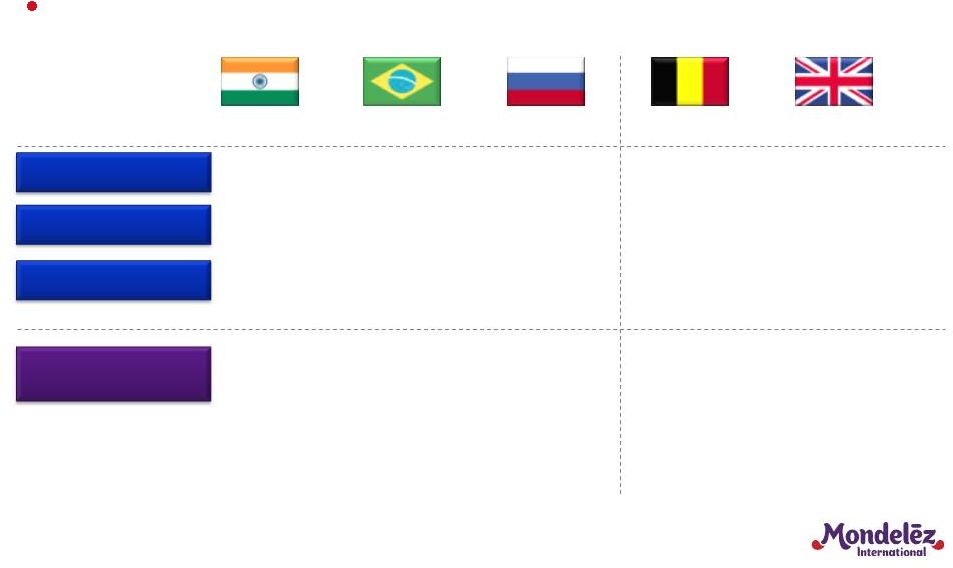 India
Brazil
Russia
Belgium
UK
2.0
0.1
18.6
1.4
22.2
4.6
42.5
5.2
55.7
10.5
3,400
10,900
15,900
37,900
35,100
8.3
7.5
3.8
2.1
1.6
Affinity Countries:
•
So. Africa
•
Indonesia
•
China
•
Egypt
•
Argentina
•
Mexico
•
Turkey
•
USA
•
Germany
•
France
•
Austria
•
Ukraine
•
Poland
Developing Markets will be the primary driver
of our future growth
63
Source: Euromonitor, AC Nielsen/ TNS Worldpanel, Kraft Market Maturity
modeling GDP growth will power consumption in Developing Markets
GDP/capita ($)
GDP growth (%)
Snacks pcc (kg)
Chocolate pcc (kg) |
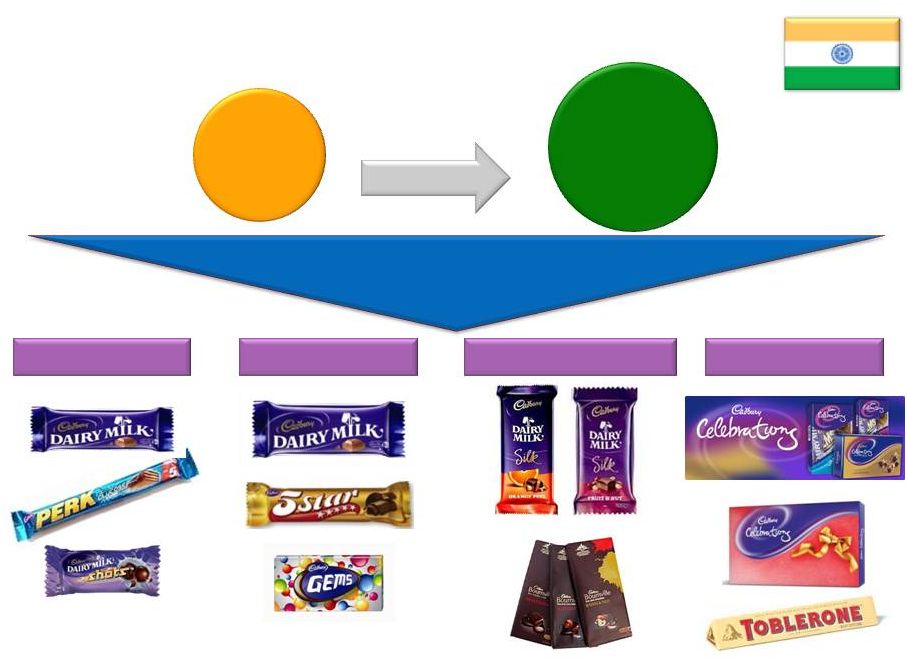 Priority Markets case study: India
64
$0.25B
Revenue
2009
$0.5B
Revenue
2011
+37% CAGR
Mainstream
Aspirants
More Special
Category growth delivered through a
consumer
&
portfolio
strategy
Gifting |
 65
Power Brand case study: Cadbury Dairy Milk
& Milka,
together
over
$3B |
 Global
innovation case study: Bubbly 66
An aerated chocolate with an innovative, playful mood
that makes chocolate tablets more exciting
Brazil
Launched June 2012
Performing above expectations
Will be in 20 major countries by end of 2013!
United Kingdom
Launched February 2012
Most successful NPD in the UK in the
last 5 years
Germany & Austria
Launched May 2012
Biggest selling SKU in the Big Size range |
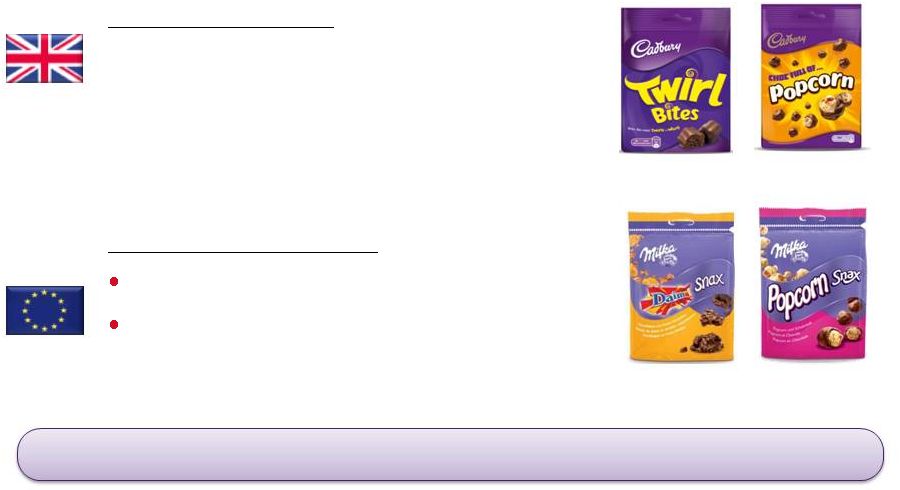 Bringing the magic of our Power Brands into new
incremental snacking occasions
Global innovation case study: Bitesize
67
United Kingdom
•
Launched in 2009
•
NPD’s growing the category: Twirl
Bites, Bitsa Wispa, Popcorn
Continental Europe
Launched in 2011
Strong share performance and
repeat in all key markets
Rolling-out to over a dozen countries by end of 2012!
|
 Continue to exceed category growth rates
Focus on Power Brands
Focus on Priority Markets
–
Lead Developing Markets growth
–
Drive category growth in
Developed Markets through
broader Snacking
Expand innovation platforms
globally
68
2011 Revenues
$10 Billion
Continue to Grow
Mid-to-High
Single Digits |
 Dave
Brearton EVP and CFO
69 |
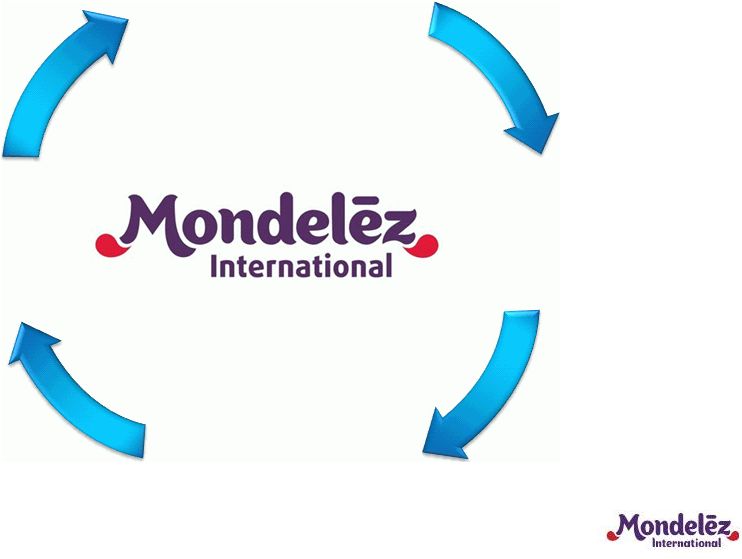 Growth
algorithm driven by virtuous cycle 70
Expand
Gross Margin
Reinvest
in Growth
Leverage
Overheads
Focus on
Power Brands &
Priority Markets |
 Expand
gross margin 71
Price to offset input cost
inflation
Optimize product mix
Target productivity of 4%+
of COGS
Key Enablers
Expand
Gross
Margin
Reinvest
in
Growth
Leverage
Overheads
Focus on
Power Brands &
Priority Markets |
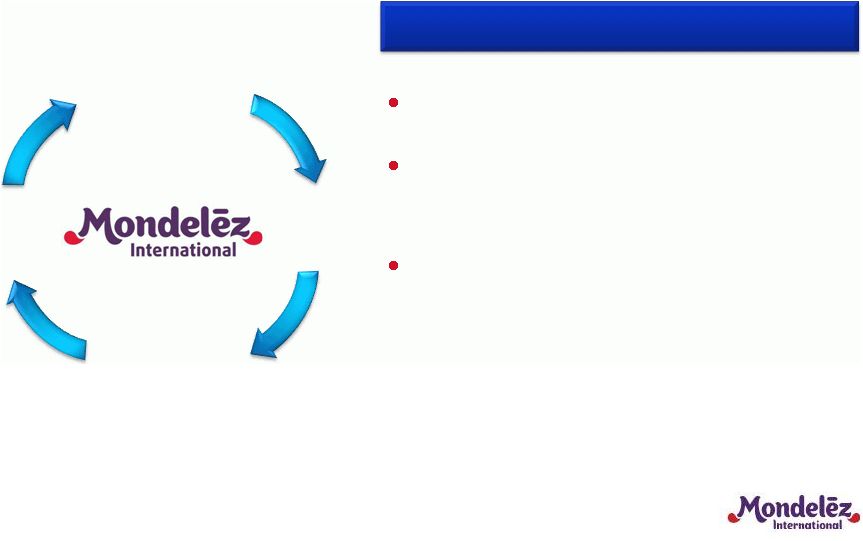 Leverage overheads
72
Top-Line Growth
Capture Restructuring Program
savings
Align overhead spending
to growth priorities
Key Enablers
Expand
Gross
Margin
Reinvest
in
Growth
Leverage
Overheads
Focus on
Power Brands &
Priority Markets |
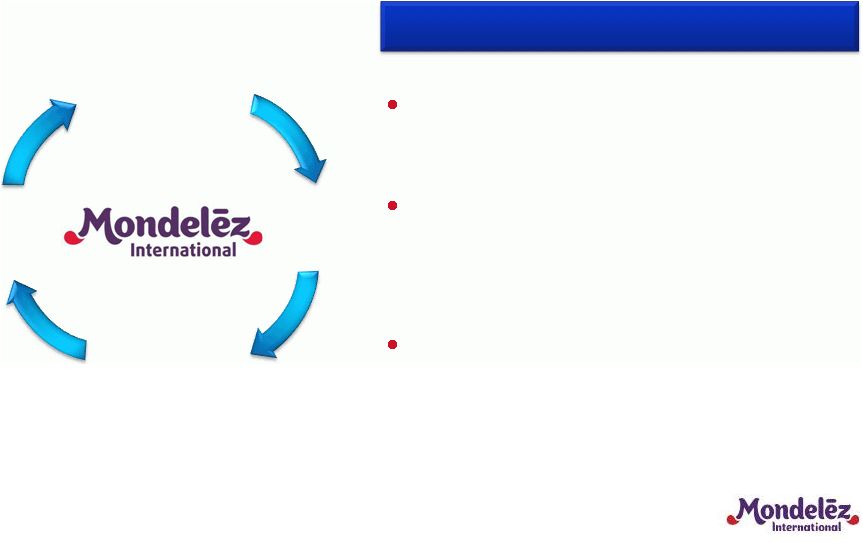 Reinvest in Growth
73
Priorities
Investments weighted towards
Developing Markets
Focus investments on Power
Brands and innovation
platforms
Capitalize on White Space
opportunities
Expand
Gross
Margin
Reinvest
in
Growth
Leverage
Overheads
Focus on
Power Brands &
Priority Markets |
 Strong
KFT results in 1H 2012 Kraft Foods (KFT) 2012 guidance
–
Organic Net Revenue growth of around 5%
–
Operating EPS of at least 9% on a constant currency basis
1H’12 results in-line with guidance
–
Organic Net Revenue growth +4.9%*
–
Operating EPS +11.4%* on a constant currency basis
Confirmed constant currency EPS guidance in
early August
–
1H’12 FX impact was $(0.02)
–
Estimate ~$(0.08) total FX impact for FY’12 (using average
August 2012 currency rates)
74
*
Reported Net Revenues declined (0.3)%. Diluted EPS increased 2.0%. See
GAAP to Non-GAAP reconciliation at the end of this presentation.
|
 2012
full year financials represent blend of KFT and Mondelez results
Q1-Q3 to reflect Kraft Foods Group as “Discontinued
Operations”
Q4 presentation to be based on actual revenue realized
and costs incurred
Full year results include variety of items
–
Stranded costs
–
Tax rate anomalies
–
Cadbury Integration Program
–
2012-2014 Restructuring Program
–
Spin-Off Costs and debt migration costs
75
- |
 Transaction-related and restructuring costs
76
KFT
MDLZ
($ billions)
Pre-
Spin
Post-
Spin
Spin-Off Costs
$0.5
$0.1
Restructuring &
Implementation Costs
$0.3
$0.8
Debt Migration Costs
$0.2
$0.4 -
$0.6 |
 Long-term financial targets will deliver
top-tier performance
77
Driving Shareholder Value
Long-Term Target
Organic Net Revenue Growth
5%-7%
Operating EPS Growth
Double-Digit
(constant FX) |
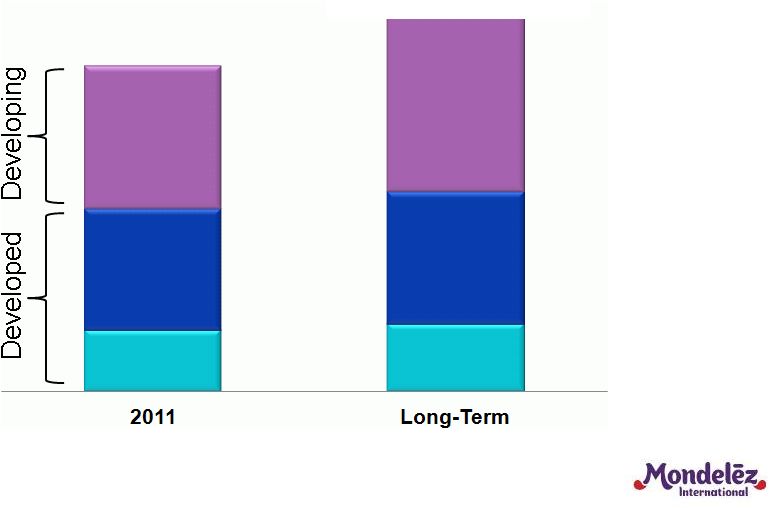 Revenue
growth target reflects large, growing Developing Markets contribution
78
Double Digit
Growth
Low-to-Mid
Single Digit
Growth
NA
EU
DM
NA
EU
DM
5%-7%
Organic Growth
$36B
*
*
Based
on
2011
reported
net
revenues;
includes
accounting
calendar
changes
and
53
rd
Week. |
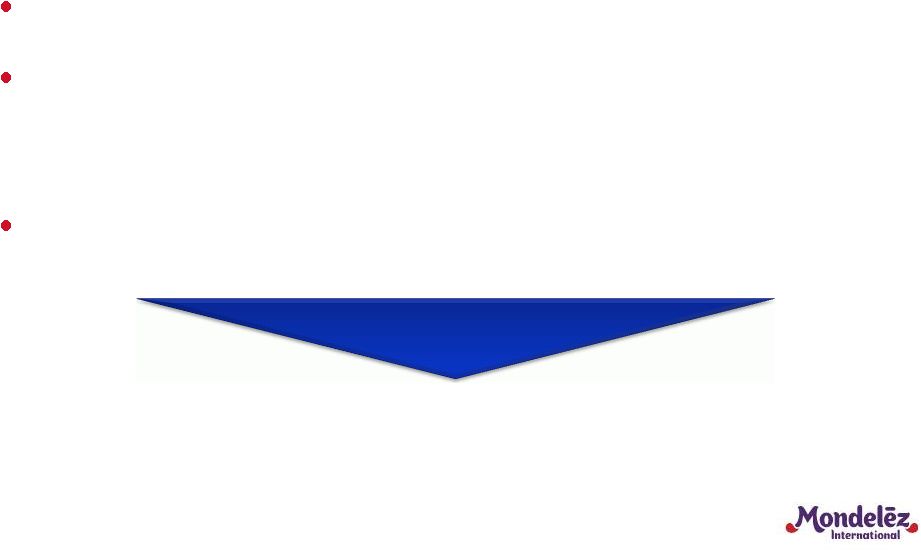 Long-term EPS target reflects the following
assumptions
Operating income growth of high single digits
Interest expense essentially flat
–
Opening debt balance of ~$20B, weighted average
interest rate of ~5.75%
Tax rate in the mid-20’s
79
Double-Digit Operating EPS Growth
(constant FX) |
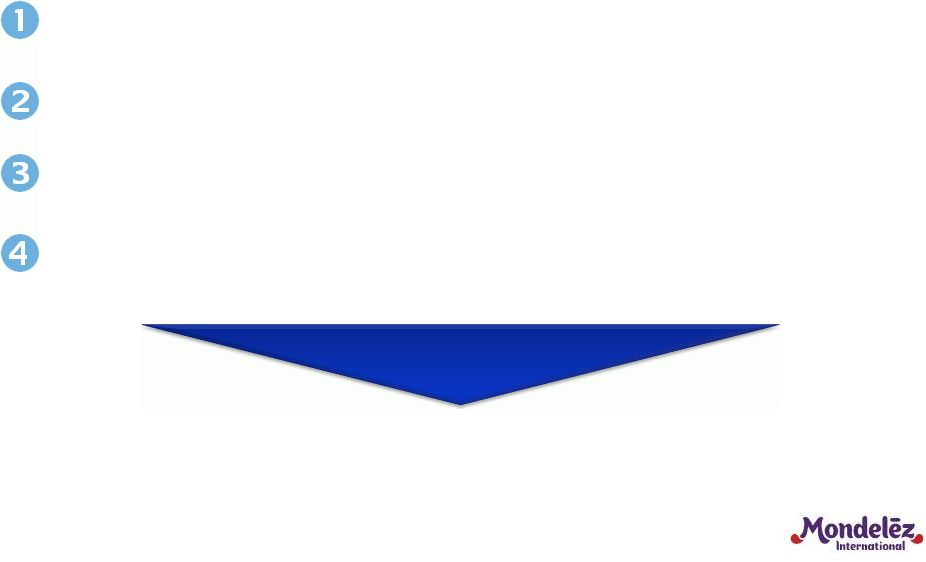 Priorities
for
free
cash
flow
Reinvest in the business to drive top-tier growth
Tack-on M&A, especially in Developing Markets
Return of capital to shareholders
Pay down debt to preserve balance sheet flexibility
80
Disciplined Capital Deployment |
 2013
outlook consistent with long-term profile Organic net revenue growth of
5%-7% Operating EPS of $1.50 -
$1.55
–
Strong Operating Income growth at constant FX
–
Significant FX headwind of $(0.15) vs. average 2011 rates*
–
Tax rate in the mid-20’s
81
* Based on average August 2012 currency rates |
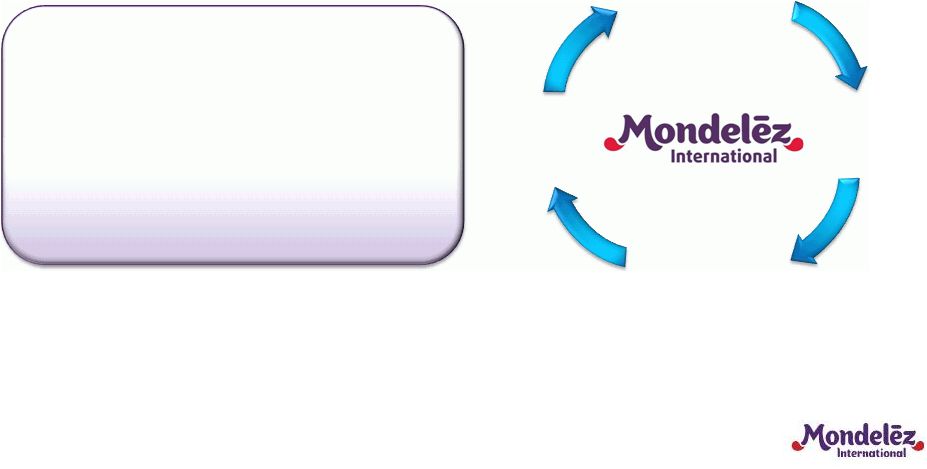 Long-term targets reflect benefits of driving
a virtuous cycle
82
Expand
Gross
Margin
Reinvest
in
Growth
Leverage
Overheads
Focus on
Power Brands &
Priority Markets
Operating
EPS Growth
5%-7%
Double-Digit
(constant FX)
Organic Net
Revenue Growth
Long-Term Targets |
 Irene Rosenfeld
Chairman and CEO
83 |
 Mondelez International is a unique investment vehicle
84
Fast-
Growing
Categories
Advantaged
Geographic
Footprint
Favorite
Snacks
Brands
Strong
Route-to-
Market
Proven
Innovation
Platforms
World-Class
Talent &
Capabilities
- |
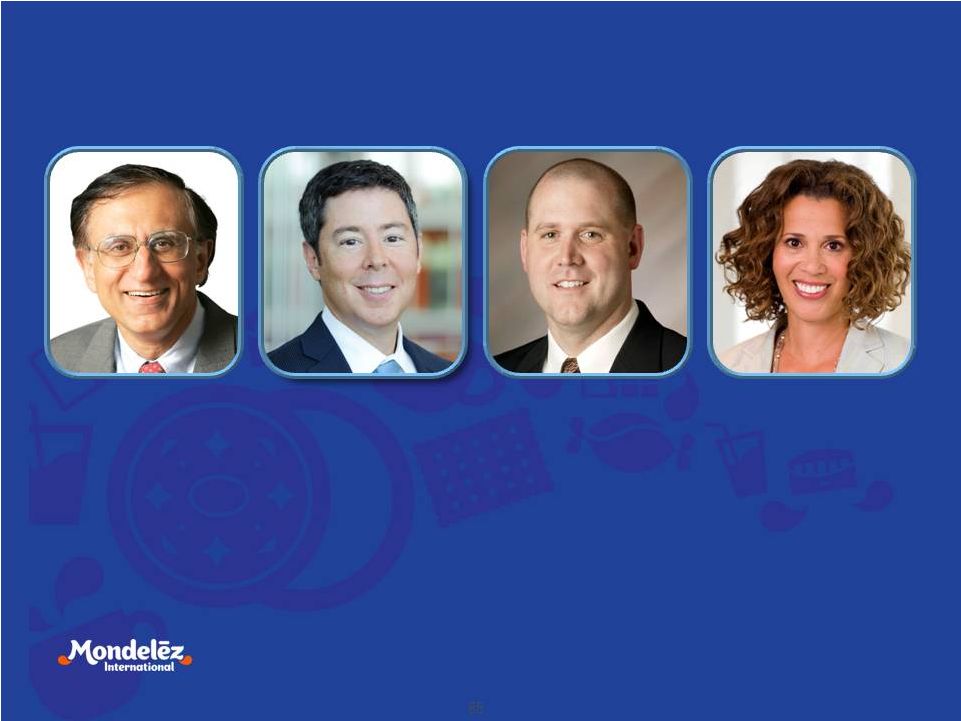 Joining for Q&A
85
Sanjay Kholsa
President
Developing
Markets
Tim Cofer
President
Europe
Mary Beth West
EVP and Chief
Category and
Marketing Officer
Mark Clouse
President
North
America |
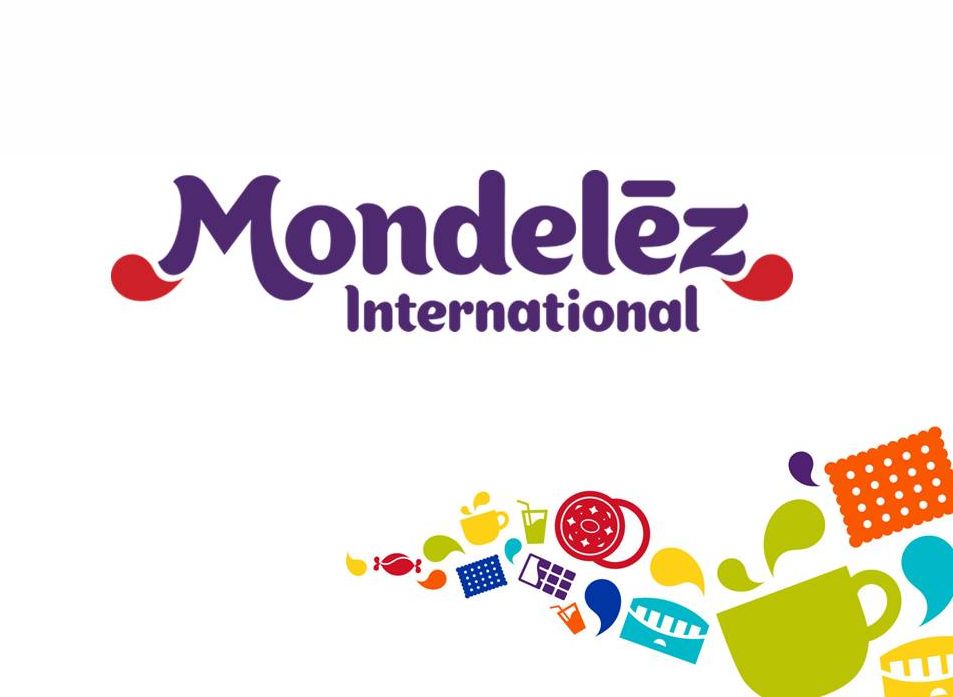 86 |
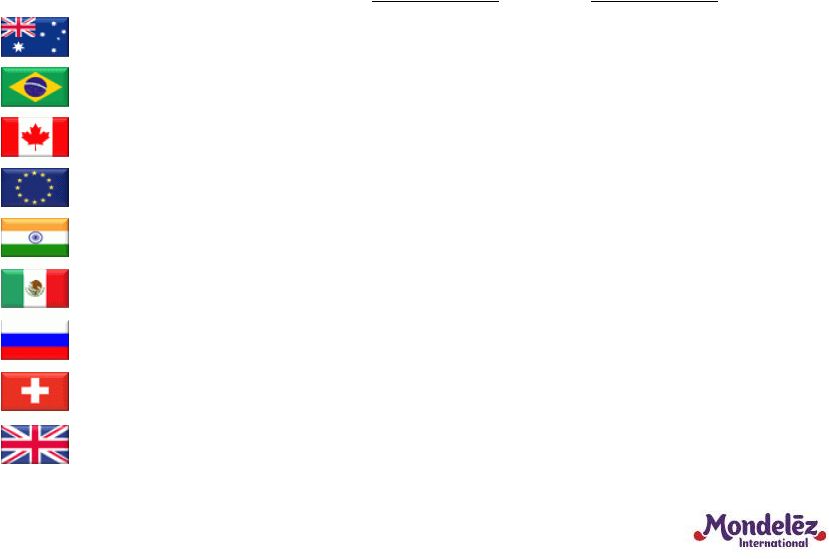 Average foreign currency rates for key countries
87
Russian Ruble
Mexican Peso
Euro
Indian Rupee
Brazilian Real
Canadian Dollar
31.92 / $US
13.17 / $US
US$1.24 / €
55.51 / $US
2.03 / $US
US$1.01 / $Cdn
August 2012
Australian Dollar
Pound Sterling
US$1.57 / £
US$1.05 / AUD
August 2011
28.67 / $US
12.20 / $US
US$1.43 / €
45.28 / $US
1.59 / $US
US$1.02 / $Cdn
US$1.64 / £
US$1.05 / AUD
Source: Oanda
Swiss Franc
0.88 / $US
0.78 / $US |
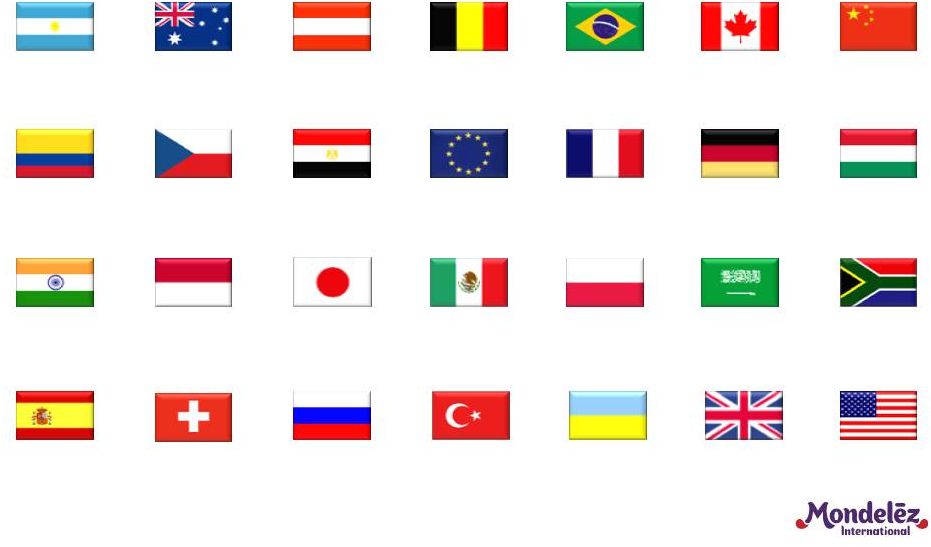 Key to
flags used in presentation 88
Indonesia
Australia
Czech
Republic
Russia
Mexico
Ukraine
Belgium
European
Union
India
Spain
Colombia
Argentina
Egypt
Japan
Austria
Turkey
Brazil
United
Kingdom
Poland
France
China
South
Africa
Hungary
Germany
United
States
Canada
Saudi
Arabia
Switzerland |
 Developing Markets as a percentage of revenue –
source detail
Unilever –
Emerging markets per 2011 annual report
Danone –
Emerging markets per 2011 results presentation
Colgate –
Emerging markets per 2011 annual report
Coca-Cola –
Pacific, Latin America, Eurasia & Africa, Bottling Investments per 2011
10-K (note: developing and emerging markets represent 57% of
volume per CAGNY 2012 presentation) Nestlé
–
Emerging markets per 2011 annual report
P&G –
Developing markets per fiscal 2012 earnings call
Kimberly-Clark –
Asia, Latin America and Other per 2011 10-K
PepsiCo –
Developing and emerging markets per CAGNY 2012 presentation
Heinz –
Emerging markets per fiscal 2012 annual report
Kellogg –
Emerging markets pro forma for Pringles per CAGNY 2012 presentation
Clorox –
Latin America and Asia fiscal 2011 per CAGNY 2012 presentation
Hershey –
Sales outside NA are 10% of net revenue with Mexico, Brazil, China and India
about 7% of net revenue per Investor Day presentation June 2012.
General Mills –
Asia Pacific, Latin America per fiscal 2012 earnings release
Campbell –
Developing markets per Deutsche Bank Consumer Conference presentation
June 2012
89 |
 GAAP to
Non-GAAP Reconciliation 90
As Reported
(GAAP)
Impact of
Divestitures
(1)
Impact of
Accounting
Calendar
Changes
Impact of
Currency
Organic
(Non-GAAP)
As Reported
(GAAP)
Organic
(Non-GAAP)
2012
Kraft Foods
26,379
$
-
$
-
$
884
$
27,263
$
(0.3)%
4.9%
2011
Kraft Foods
26,451
$
(91)
$
(361)
$
-
$
25,999
$
(1)
Impact of divestitures includes for reporting purposes Starbucks CPG business.
Net Revenues to Organic Net Revenues
For the Six Months Ended June 30,
($ in millions, except percentages) (Unaudited)
% Change |
 GAAP
to Non-GAAP Reconciliation 91
As Reported
(GAAP)
Integration
Program
costs
(1)
Spin-Off
Costs
(2)
2012 - 2014
Restructuring
Program costs
(3)
Operating
(Non-GAAP)
Currency
(4)
Operating
Constant FX
(Non-GAAP)
As Reported
EPS Growth
(GAAP)
Operating
EPS Growth
(Non-GAAP)
Operating
Constant FX
EPS Growth
(Non-GAAP)
2012
Diluted EPS attributable to Kraft Foods
1.03
$
0.04
$
0.12
$
0.06
$
1.25
$
0.02
$
1.27
$
2.0%
9.6%
11.4%
2011
Diluted EPS attributable to Kraft Foods
1.01
$
0.13
$
-
$
-
$
1.14
$
-
$
1.14
$
(1)
Integration Program costs are defined as the costs associated with combining the Kraft Foods and
Cadbury businesses, and are separate from those costs associated with the acquisition. Integration Program
costs were $78 million, or $73 million after-tax including certain tax costs
associated with the integration of Cadbury, for the six months ended June 30, 2012, as compared to $240 million, or $234 million
after-tax for the six months ended June 30, 2011.
(2)
Spin-Off Costs represent non-recurring transaction and transition costs associated with
preparing the businesses for independent operations consisting primarily of financial advisory fees, legal fees,
accounting fees, tax services and information systems infrastructure duplication, and
financing and related costs to redistribute debt and secure investment grade ratings for both the North American
Grocery Business and the Global Snacks Business. Spin-Off Costs for the six
months ended June 30, 2012 were $301 million, or $202 million after-tax and include $162 million of pre-tax
financing and related costs recorded in interest and other expense, net.
(3)
Restructuring Program costs for the six months ended June 30, 2012 were $169 million, or $107
million after-tax and represent non-recurring restructuring and related implementation costs reflecting primarily
severance, asset disposals and other manufacturing related non-recurring
costs. (4)
Includes the favorable foreign currency impact on Kraft Foods foreign denominated debt and
interest expense due to the strength of the U.S. dollar. Diluted Earnings per Share to Operating EPS
For the Six Months Ended June 30,
(Unaudited)
% Growth |
 GAAP
to Non-GAAP Reconciliation 92
As Reported
(GAAP)
Impact of
Divestitures
Impact of
Acquisitions
(1)
Impact of
Integration
Programs
Impact of
Accounting
Calendar
Changes
(2)
Impact of
Currency
Organic
(Non-GAAP)
As Reported
(GAAP)
Organic
(Non-GAAP)
For the Twelve Months Ended December 31,
2010
13,613
$
-
$
(4,753)
$
1
$
(150)
$
15
$
8,726
$
71.1%
9.9%
2009
7,956
$
(14)
$
-
$
-
$
-
$
-
$
7,942
$
For the Twelve Months Ended December 31,
2011
15,821
$
-
$
(379)
$
1
$
(183)
$
(397)
$
14,863
$
16.2%
11.2%
2010
13,613
$
(105)
$
-
$
1
$
(148)
$
-
$
13,361
$
For the Six Months Ended June 30,
2012
7,821
$
-
$
-
$
-
$
-
$
459
8,280
$
2.2%
9.5%
2011
7,656
$
-
$
-
$
-
$
(92)
-
$
7,564
$
Net Revenues to Organic Net Revenues
($ in millions, except percentages) (Unaudited)
% Change
Kraft Foods Developing Markets
(1)
Impact
of
acquisitions
reflects
the
operating
results
from
our
Cadbury
acquisition
on
February
2,
2010.
(2)
Includes
the
impacts
of
accounting
calendar
changes
and
the
53
week of shipments in 2011.
rd |
 GAAP to
Non-GAAP Reconciliation 93
As Reported
(GAAP)
Integration
Program Costs
(1)
Acquisition-
Related Costs
(2)
Spin-off Costs
(3)
2012 -
2014
Restructuring
Program Costs
(4)
Adjusted
(Non-GAAP)
Segment Operating Income
1,577
$
181
$
25
$
-
$
-
$
1,783
$
Segment Operating Income Margin
11.6%
13.1%
Segment Operating Income
2,053
$
161
$
-
$
-
$
-
$
2,214
$
Segment Operating Income Margin
13.0%
14.0%
Segment Operating Income
1,069
$
39
$
-
$
-
$
5
$
1,113
$
Segment Operating Income Margin
13.7%
14.2%
Kraft Foods Developing Markets
Operating Income To Adjusted Operating Income
($ in millions, except percentages) (Unaudited)
(1)
Integration Program costs are defined as the costs associated with combining the Kraft Foods and
Cadbury businesses, and are separate from those costs associated with
the acquisition. (2)
Acquisition-related costs include transaction advisory fees, U.K. stamp taxes and the
impact of the Cadbury inventory revaluation. (3)
Spin-Off Costs represent non-recurring transaction and transition costs associated with
preparing the businesses for independent operations consisting primarily of
financial advisory fees, legal fees, accounting fees, tax services and information systems infrastructure duplication.
(4)
Restructuring Program costs represent non-recurring restructuring and related
implementation costs reflecting primarily severance, asset disposals and other manufacturing
related non-recurring costs. For
the
Twelve
Months
Ended
December
31,
2010
For
the
Twelve
Months
Ended
December
31,
2011
For
the
Six
Months
Ended
June
30,
2011 |
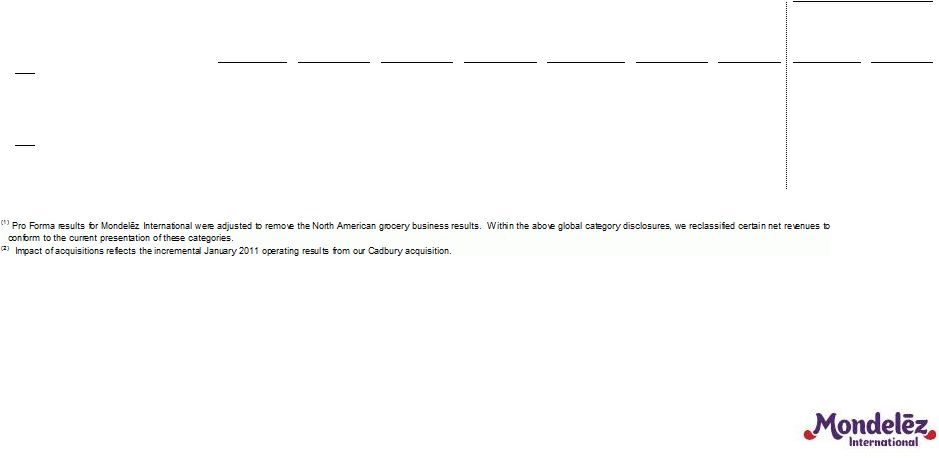 GAAP
to Non-GAAP Reconciliation 94
Mondelez
International
Pro Forma
Continuing
(1)
(GAAP)
Impact of
Divestitures
Impact of
Acquisitions
(2)
Impact of
Integration
Program
Impact of
Accounting
Calendar
Changes
Impact of
Currency
Mondelez
International
Pro Forma
Organic
(Non-GAAP)
Mondelez
International
Pro Forma
Continuing
(1)
(GAAP)
Mondelez
International
Pro Forma
Organic
(Non-GAAP)
2011
Biscuits
10,997
$
-
$
-
$
-
$
(221)
$
(219)
$
10,556
$
11.8%
8.9%
Chocolate
9,566
-
(287)
-
(143)
(361)
8,775
15.6%
5.9%
Gum & Candy
5,698
-
(382)
1
(3)
(158)
5,155
8.9%
0.8%
2010
Biscuits
9,837
$
-
$
-
$
-
$
(147)
$
-
$
9,690
$
Chocolate
8,276
11
-
1
(3)
-
8,285
Gum & Candy
5,231
(117)
-
-
(0)
-
5,114
Net Revenues to Organic Net Revenues by Global Category
For the Twelve Months Ended December 31,
($ in millions, except percentages) (Unaudited)
% Change
-
-
-
- |
